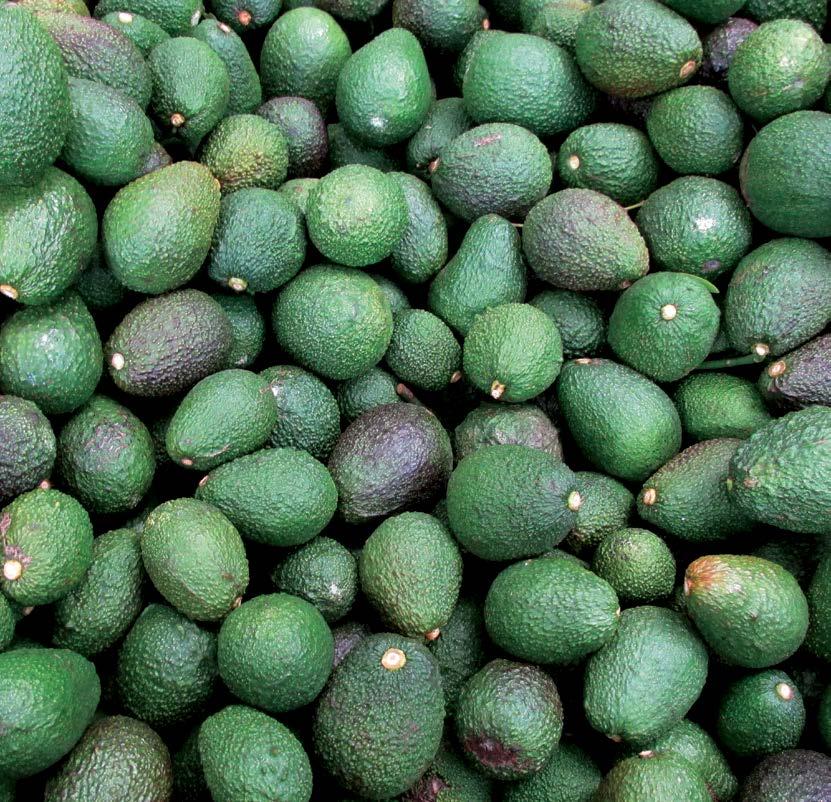
18 Grey nomads alleviate labour shortages 32 Smooth season for Tasman apples 38 Hard slog for young horticulturalists Avocados –where to from here? Page 16 VOL 96 | NO 03 | APRIL 2023 In this issue
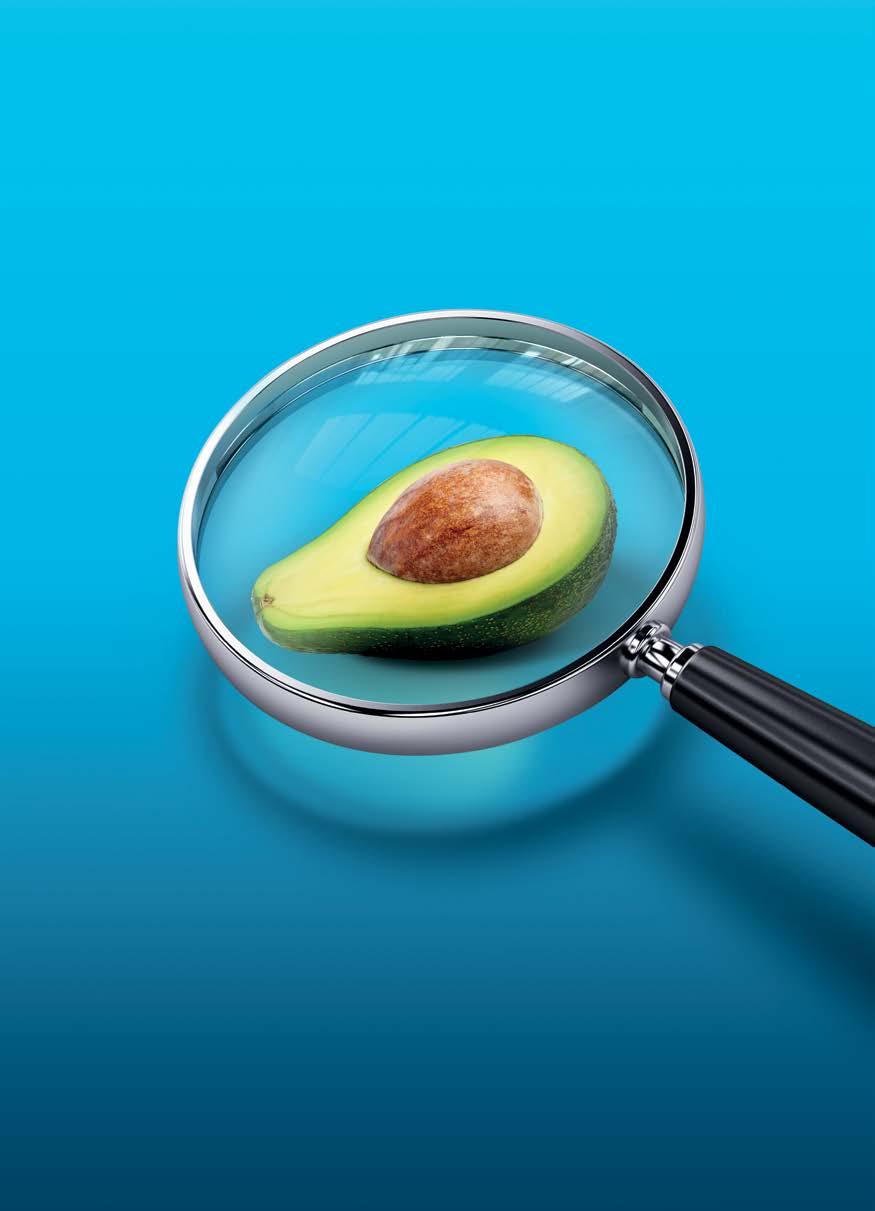

®Tri-Base Blue is a registered trademark of Nufarm Australia Ltd. Exclusive to Small particles, big protection ONF207493NF Growers who know the science use Tri-Base Blue. ® Its ultra-fine copper particles cover a greater surface area than alternatives - exerting full potency against Anthracnose. • Superior coverage and adhesion • Proven performance • Easy measurement and handling in 10L and 640L For more information contact your Fruitfed Technical Horticulture Representative or visit us at nufarm.co.nz/tri-base-blue
50 Good feijoa crop this season but support needed
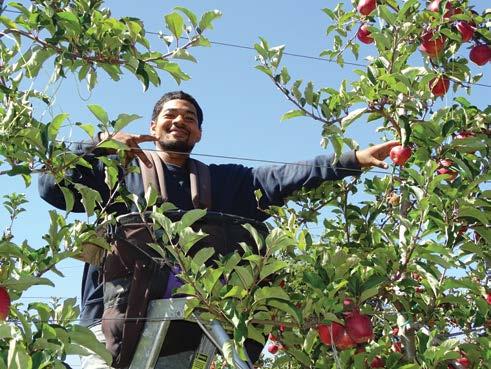
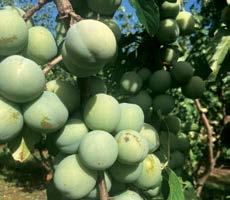

51 Facing the future at the World Avocado Congress
Technical
53 Cyclone Gabrielle: “Management of a disaster often ends up more important than the disaster itself”
58 A summer of floods and droughts, and very warm
What’s New
A regular advertorial section of new products and services. This publication does not endorse the products or services featured here.
60 The new John Deere 5ML tractor is coming

Up Front
President’s Word: Why did growers establish HortNZ?
The Chief Executive: Food prices make the news – again. Cross party action needed
2
5
6 Natural resources and environment Your Industry 9 Piopio’s roadside berry business 12 Flood through Te Karaka orchard ‘like a washing machine’ 16 Hard decisions facing Northland avocado growers 18 Grey nomads loving the lifestyle 22 Family values are key for Darling Group
regional response on the ground 29 Hybrid autonomous vehicle developed in NZ wins favour in US 32 Labour and ships return to Tasman for harvest 34 Heritage plums increasingly popular in recent years 36 Eve’s degrees prove ‘literally’ ideal for horticulture 38 Young horticulturalists look to the future after Cyclone Gabrielle 42 Plant Pass biosecurity – increasing resilience and trust 44 Tractor donations helping Tonga recover from eruption 46 Defying the odds 49 Summerfruit cyclone recovery
Your Levy at Work
26 Tairāwhiti
Contents APRIL 2023 32 34 9 44 The ORCHARDIST : APRIL 2023 1
Why did growers establish HortNZ?
In my column recently, I talked about the need for horticulture industry good bodies to have a serious discussion on finding ways to better collaborate.
Barry O’Neil : HortNZ president
The Horticulture New Zealand Board and I believe there are opportunities that we need to pursue. Continuing the collaboration theme, I thought it would be useful to give the background behind establishing HortNZ, in part to stop any risk of reinventing the wheel as we enter into these discussions.
HortNZ was formed in 2005 by the merger of the New Zealand Vegetable and Potato Growers’ Federation (Vegfed) and the New Zealand Fruitgrowers’ Federation (NZFF). HortNZ was formed to be future focused, a united voice for the industry, and deliver measurable benefits for members.
Earlier attempts to unite the primary sector had been tried but had failed. As early as the 1940s, there was a proposal to merge the Dominion Council – an early grower body – and Federated Farmers, but growers were concerned about their interests being dominated by bigger pastoral interests, so this proposal didn’t proceed. It really wasn’t until the rise of the powerful supermarkets, and along with this the demise of the auction system, that serious discussion started to happen about collaboration to achieve a stronger voice for horticulture.
Larger growers were developing direct relationships with the supermarkets, which left smaller growers struggling to see how they would survive. This period was one of significant disruption for the sector, which also coincided with the economic reforms of the 1980s.

In 1990, a ‘Land User Forum’ was proposed to represent the interests of NZFF, Vegfed, Federated Farmers, grape growers, and pig and deer farmers. It was to be a broad rural lobby group for common issues, including land use, environment, rural social services, economics, and biosecurity. After years of trying to make it happen, the idea failed due partly to concerns similar to those raised by the reforms tried in the 1940s.
A more targeted consolidation effort was made in 1995, when it was proposed that United Fresh become the de facto representative body for the whole fresh produce industry, including growers, wholesalers and retailers. It was proposed that each component would provide funding to achieve this outcome, through an equitable funding initiative that included the supermarkets. But the supermarkets didn’t buy into this approach and the proposal collapsed. Merging NZFF and Vegfed was originally proposed in 1990 by the then President of Vegfed, Keith Jowsey. However, the idea didn’t start to get traction until after these other initiatives had failed. In 1997, the two organisations signed a closer working relationship. It was considered that such a merger would result in better use of staff talents, achieve greater critical mass and therefore, greater effectiveness that ultimately would result in cost savings.
Earlier attempts to unite the primary sector had been tried but had failed
From the closer working relationship, a more specific merger proposal was put to the members of the two organisations in 2003, seeking support for a more broadly based industry representative body, due to the common issues of resource management, compliance costs, market access, trade, labour, food safety, biosecurity, and industry profile.
The proposal suggested growers needed a more powerful, influential, results focused, effective and proactive representative body, whose critical mass would
2 The ORCHARDIST : APRIL 2023 PRESIDENT’S WORD
ensure its voice was heard above the numerous other competing lobby groups. There was recognition of the significant challenges to the sector, and that a single voice from HortNZ would be more powerful than multiple disparate voices.
Feedback on the proposal resulted in a HortNZ establishment group being set up in May 2004 to develop the final proposal. Key members of the group were kiwifruit, berryfruit and apple growers, Summerfruit New Zealand, Vegfed and NZFF, who engaged with grower organisations throughout the country to receive submissions. This process resulted in remits at the 2004 NZFF and Vegfed Annual General Meetings being supported to create HortNZ and disestablish those two organisations.

good bodies
The late Jim Anderton, as Minister of Agriculture at the 2005 launch in Wellington, stated it was so sensible for industry groups to combine limited resources into one larger entity to achieve greater efficiency and effectiveness. He also said that for government, it was ideal if it could liaise with one industry organisation when working on issues that have a national impact.
Product groups previously affiliated with NZFF and Vegfed became affiliated to HortNZ, with HortNZ focused primarily on influencing government policy settings and advocating
It is appropriate that we challenge ourselves and look at whether we can achieve even greater results from the investment our growers are making in horticulture industry
HortNZ was formed by the merger of: HortNZ
New Zealand Fruitgrowers’ Federation (NZFF)
ENABLING GROWERS TO BE WORLD LEADING 021 827 831 vicky@gnl.nz mike@gnl.nz 021 242 6400 BUDDING NOW Have you placed your 2024 & 2025 orders?
New Zealand Vegetable and Potato Growers’ Federation (Vegfed)
Editors:
Emily Pope
Ph: 027 617 6200
Email: emily.pope@hortnz.co.nz
Andrew Bristol
Ph: 021 021 62 021
Email: andrew.bristol@hortnz.co.nz
Advertising Manager:
Jackie Enright
Ph: 04 494 9986
Mobile: 0274 489 913
Email: jackie.enright@hortnz.co.nz
Design:
Scenario.co.nz
Ph: 04 385 9766
Email: joy@scenario.co.nz
Subscriptions:
Email: info@hortnz.co.nz
at the national level for all growers. Product groups were focused primarily on their growers’ needs, being the voice for their growers, practically supporting their growers, and helping to maximise returns.
Since then, HortNZ and product groups have worked closely together to deliver successfully what they were set up to achieve. But in 2023 it is a far more complex and faster moving world than it was in 2005. As a result, it is appropriate that we challenge ourselves and look at whether we can achieve even greater results from the investment our growers are making in horticulture industry good bodies.
Everyone has limited resources. To me, the very last thing we would want to do is to increase the amount growers must fund in order to manage the plethora of growing challenges we are all facing, which
history shows us are likely to get even more complicated in the future. In doing my research for this article, there are some great industry leaders that I would like to acknowledge, who worked really hard to realise how horticulture needed to join together. These leaders include Keith Jowsey, Brian Gargiulo, Max Lilley, Tony Ivicevich, Ron Becroft, Paul Heywood, Martin Clements and Andrew Fenton.
The HortNZ Board has an open mind on options for better collaboration, and it’s good to see a number of product groups are also engaging on this. Let’s keep the momentum going and keep challenging ourselves until we are satisfied we have done everything to find the best approach to support growing and horticulture for the next 20 years.
 Kia kaha.
The first HortNZ board: back row (L to R): Debbie Hewitt, Peter Scott, Ru Collin, Peter Silcock (chief executive), Tony Ivicevich, David Eder, (seated) Brian Gargiulo, Andrew Fenton (president) and John Allen
Kia kaha.
The first HortNZ board: back row (L to R): Debbie Hewitt, Peter Scott, Ru Collin, Peter Silcock (chief executive), Tony Ivicevich, David Eder, (seated) Brian Gargiulo, Andrew Fenton (president) and John Allen
2005
AT WORK
This publication uses vegetable based inks and environmentally responsible paper produced from Forest Stewardship Council® (FSC®) certified, Mixed Source pulp from Responsible Sources.
PRESIDENT’S WORD
Paper produced using Elemental Chlorine Free (ECF) and manufactured under the strict ISO14001 Environmental Management System.
The wrapper we use is 100% recyclable, it is LDPE 4 (Low Density Polyethylene) Soft Plastic and meets the required standards. For further information refer to: https://www.recycling.kiwi.nz/our-story
Food prices make the news – again. Cross party action needed
Food prices have been in the news again since Statistics New Zealand’s release of the February 2023 food price index.
Nadine Tunley : HortNZ chief executive

Statistics New Zealand headlined its media release with “12 percent annual increase in food prices highest since September 1989,” noting that “fruit and vegetable prices increased by 23 percent.”
Once again, the increase in fruit and vegetable prices got the media’s attention. But the industry was ready, outlining the impact of adverse weather on supply and suggesting that the public should support domestic growers by continuing to buy fresh, locally grown and healthy fruit and vegetables.
Cyclone Gabrielle and other adverse weather events since early October last year (when unseasonal frosts wiped out some kiwifruit growers) have highlighted New Zealand’s vulnerability when it comes to food security and supply. We just can’t assume any longer that ‘she’ll be right’ when it comes to primary production in this country.
Government policy makers and decision makers need to come together quickly
While the focus post Cyclone Gabrielle has been on the clean-up and grower support and wellbeing, industry experts, government policy makers and decision makers need to come together quickly to develop an approach to food security and supply in New Zealand. This approach needs to inform the reform of the Resource Management Act, which at the moment, does not prioritise food security and supply.
The Labour Government under new Prime Minister, Chris Hipkins, is making directional policy changes to appeal
to ‘middle New Zealand’. While there’s no real definition for ‘middle New Zealand’, I would say they used to be the people who didn’t worry too much about the price of food. But that the number of middle New Zealanders is decreasing.
Members of Parliament from across all political parties are worried about the cost of living and its impact on increasing numbers of New Zealanders. At the same time, increasing numbers of New Zealanders are concerned about their society, health and education metrics that are going in the wrong direction, and the impact of the increasing number of adverse weather events on people’s lives and livelihoods.
New Zealand is not known for its strategic direction and planning. Sometimes this is blamed on our comparatively short, three-year government term. It would be a pity if, in the scramble to win the next election, New Zealand’s long-term prosperity and societal wellbeing became a political football, when increasing numbers of New Zealanders are under extreme pressure, due to the impact of the weather and/or the impact of unescapable inflation, as evidenced by the food price index.
Our industry’s message to politicians – current and aspiring – is to engage with us and listen to the solutions that we have. Our industry’s track record of innovation, growth and environmental stewardship is right up there on the international stage.
Just as we’ve said before, with good planning, New Zealand can have houses and food. With good planning and clear outcomes, New Zealand can adapt to climate change, have enough healthy food for all, and the kind of safe, inclusive society that we all want.
The ORCHARDIST : APRIL 2023 5 THE CHIEF EXECUTIVE
YOUR LEVY AT WORK
INDUSTRY WIDE ISSUES FOR INDUSTRY GOOD
Natural resources and environment
 Michelle Sands : HortNZ strategy and policy manager
Michelle Sands : HortNZ strategy and policy manager
Submission on the Severe Weather Emergency Legislation Bill
The general purpose of the Severe Weather Emergency Legislation Bill is to assist recovery and improve resilience in the areas affected by severe weather events. It helps councils take immediate action by enabling remote attendance at meetings, facilitating planning and decisionmaking, and allowing for concurrent declarations of states of emergency and transition periods. Specifically, amendments will:
• ensure emergency powers are available to be exercised efficiently, allowing local authorities an alternative way to provide notice of entry for emergency response activities
• modify statutory time frames that are not practical for businesses or individuals to meet
• for a limited time, recategorise certain emergency response activities carried out by rural landowners and occupiers as permitted activities and facilitate planning and decision-making by all local authorities.
Horticulture New Zealand spoke to the Select Committee in March, where we supported and welcomed the Emergency Legislation. We sought changes to the provisions to consider the Food Act, to ensure extensions are provided under the emergency legislation and that registration will be maintained so people can continue to trade.
We also spoke about the provisions enabling cyclone response activities undertaken by rural landowners and
occupiers on rural land. We supported the provisions and emphasised the need to repair damage and restore the productivity of growing land responsibly and efficiently. We also asked that the legislation acknowledge that some of this work will take months to complete.
We sought changes to the provisions… so people can continue to trade
We pointed out that not all necessary activities will have a pathway under the emergency legislation. A large volume of wood debris from upstream was deposited on growers’ land. Some of this wood debris is intertwined with materials that are not burned under normal circumstances, such as coated wire. We accept that specific and careful management of waste is required to manage adverse effects on the air, land and water as well as human health, so the legislation must directly address this cyclone impact. As it stands, the Bill does not enable burning of prohibited materials. An Order in Council will be required to allow the burning of mixed waste.
Submission on the Natural and Built Environment Act Bill and Spatial Planning Act Bill consultations
HortNZ spoke to the Environment Select Committee twice on our submissions on the Natural and Built Environment
6 The ORCHARDIST : APRIL 2023
Bill (NBA) and the Spatial Planning Bill (SPA), the first two of three acts that will replace the Resource Management Act (RMA).
HortNZ was invited to speak in early February, as the Select Committee shaped their thinking before all written submissions were received. We asked for the inclusion of food as a “system outcome” and a matter that the National Planning Framework must address, which would carry down to all regional plans. We also emphasised that the proposed ten-year maximum water consents are not nearly long enough, and activities that achieve system outcomes should be granted longer consents.
Planning decisions often focus on short-term environmental impacts and benefits


HortNZ went back to the Select Committee in late March, following Cyclone Gabrielle. We emphasised the importance of an outcome in the National Planning Framework to protect highly productive land for primary production and climate change mitigation and adaptation because it is the land most likely to support future generations to produce low emissions food. We argued
that this resource should be protected from floods, the adverse effects from upstream land uses, as well as urban sprawl.
We highlighted the impacts of Cyclone Gabrielle on some of New Zealand’s most highly productive land in Northland, Tairāwhiti and Hawke’s Bay. The impacts on this land from flooding show that planning decisions often focus on short-term environmental impacts and benefits, without considering long-term catchment management and resilience to rare events.
Plan Change 2 Mediation on Commercial Vegetable Growing
HortNZ is participating in Mediation on Plan Change 2, an interim plan change to the Horizons One Plan that seeks to provide a consenting pathway for vegetable growers within the target water management sub-zones in Horowhenua and the Lower Rangitikei.
The original Plan Change 2 decision relied on Overseer. In response to the Overseer review, which confirmed the limitations of Overseer as a regulatory tool, farm systems experts have been working on an alternative approach for vegetable growers to demonstrate that they are managing the risk to water quality from growing vegetables. The new risk tool approach was tested with Levin growers, and HortNZ is working with other parties to agree how the alternative to Overseer can be included within the plan change.

The ORCHARDIST : APRIL 2023 7 YOUR LEVY AT WORK
YOUR INDUSTRY
ACROSS THE SECTOR — ACROSS THE COUNTRY
 Greengage
Greengage
Growers Page 34
Piopio’s roadside berry business
The King Country is not known for horticulture. The up and down landscape is better suited to the sort of agriculture that runs on four legs.
Geoff Lewis Photographs : Trefor Ward
That’s what makes Piopio Berry Orchard special and a surprise to find on the road to Taranaki.
It’s a busy hub at the end of a rank of signs advertising strawberries, blueberries, raspberries, blackberries

along with the coffee, smoothies and ice creams essential to berry growers today. Behind it are Mike and Angela Roy.
Mike comes from an apple-growing background, having obtained a horticultural qualification through Massey in the 1980s. Mike and Angela ran their own orchard at Ohaupo ten minutes south of Hamilton on SH3, which is still landmarked by two 2.5m cartoon cows Mike built near the roadside.
In 1993 they bought the Piopio site 20 minutes’ drive south of Te Kuiti and just a few clicks from the settlement of the same name, and ran both operations for two years.
‘’The orchard was originally planted in the 1980s. When we bought it we sold fruit, vegetables and berries but then we decided to concentrate on berries.
‘’When we got here it had a 4ha block of blueberries and a small orchard with older varieties cultivated using the old-style ‘Lincoln Canopy’ method. We dismantled it and reused the materials.’’
Today, Piopio Berry Orchard comprises 6ha of blueberries, all under bird netting, 2ha of strawberries – with half of the varieties (Albion and Monterey) under tunnel housing and the other half (Camorosa) in the open, and a couple of hectares in raspberries and blackberries.
In a ‘normal’ season Piopio produces around 50 tonnes of strawberries, 30 tonnes of blueberries and five tonnes of raspberries and blackberries. The aim is to grow more
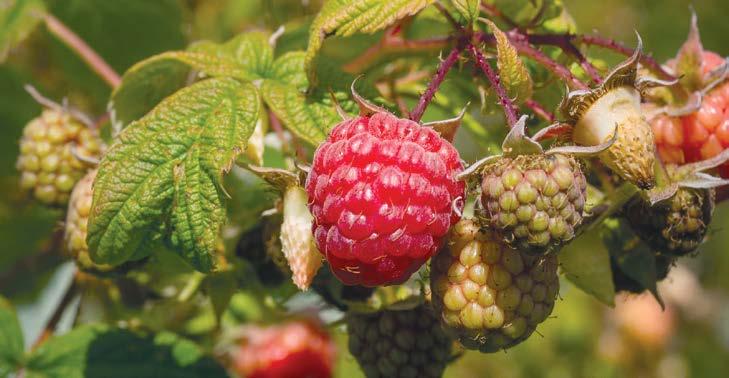
–
The ORCHARDIST : APRIL 2023 9 YOUR INDUSTRY
Late season raspberries
berries under cover in tunnel houses. This is to extend the fruiting period and match it to the time the orchard’s shop is open during the year.
‘’We sell fresh berries and a lot as frozen product. Our usual problem is we don’t have enough to meet demand,’’ Mike says.
When it comes to horticultural pests, Piopio is saved by its isolation, Mike explains.
‘’There’s no one else doing the same thing in near 100kms in any direction, with the advantage being we don’t get infested by pests from other operations.’’
This area of the King Country is limestone, and Piopio Berry Orchard rests in a wide valley of fertile soil consisting of the famous volcanic Mairoa Ash. While it gets enough rain, it hasn’t suffered from any significant floods so far –and only received a few drops of rain during the Cyclone Gabrielle event.
Harvesting is by local workers, Angela explains. ‘’When we started here people told us we were mad and that we’d never get enough labour. But we found the local community was very supportive. We employ about 80 people at the height of the season in January, pickers and packers, with eight to ten in the shop. Some are students from Piopio and Te Kuiti colleges. People will ring us up to get on the list.’’ The workers are a flexible bunch and can be back and forth between picking, packing, working in the chillers or shop all day. More than 95 percent of product is sold to passing traffic, Mike says.
‘’It’s a very simple business, we grow, sell fresh or freeze.’’ Piopio Berry Orchard is open from October to late April and closed during the winter months. Only three years ago did Mike and Angela manage to get a holiday in summer for the first time.

The climate can be a bit hotter in summer than comparable spots, but winter can be cold and turn up a few frosts. This season’s weather, devastating in other regions, has also had its effects on Piopio both negative and positive. Production is running three weeks late, freezers and coolstores which should be full at this time are half empty. The Antarctic blast in October last year – the coldest snap in about 25 years, Mike says – burned the flowers and greatly reduced and retarded the fruit-set.
On the upside, the orchard is on the main road south to the ‘Naki’.
‘’Something we have noticed is increasing numbers of tourists,’’ Angela says, ‘’probably as they can’t go north or to Hawke’s Bay (due to the cyclone damage) so they’re heading south and west.’’
Fifteen years ago they installed a commercial grade kitchen and expanded what was the little roadside shop
When we started here people told us we were mad and that we’d never get enough labour
Angela and Mike Roy with blueberries under bird netting
PIOPIO BERRY ORCHARD COMPRISES
~2ha
raspberries & blackberries
2ha 6ha
10 The ORCHARDIST : APRIL 2023 YOUR INDUSTRY
blueberries strawberries
into an outlet for coffees, ice cream and muffins. This has led to a general uptick in business.
Something we have noticed is increasing numbers of tourists
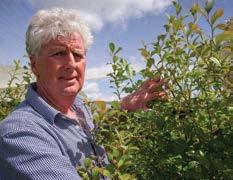
A new development is asparagus, using surplus coconut coir growing medium previously used in the hydroponic tunnel house strawberries. A trial of asparagus fern has been planted in two 50m raised beds. The plan is to extend and cover these too.
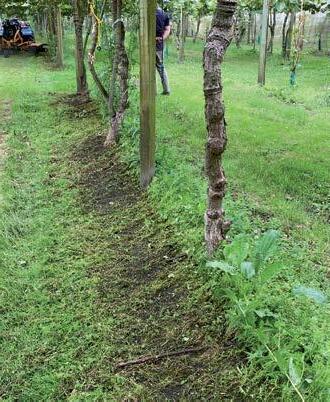
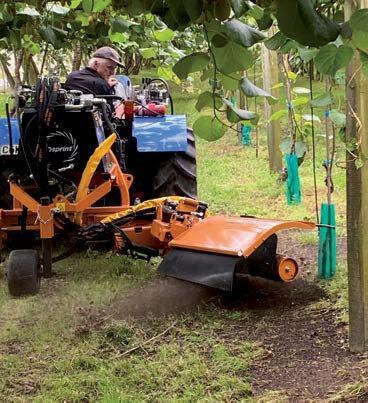

Mike and Angela take great joy in their four children, with two sons in the middle, one in the army and other in marketing, and the girls Jessie and Maggie, the eldest and youngest, add their own skills. Jessie helps on the orchard and Maggie is an accountant and has been taking care of the paperwork from Sydney.
The Roys love the lifestyle, says Angela.
‘’We’re still active and healthy and can do anything. The kids help at Christmas and the locals are fantastic. It is time consuming and we do get tired, but not too much. We sometimes think about what else we’d like to do but our heart has been here all our married life.’’
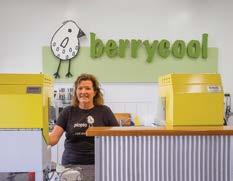
© Copyright 2023 Farmgard Ltd. All rights reserved. Specifications are subject to change without prior notice. CONTACT US NOW FOR A DEMO ON YOUR ORCHARD.
Mike Roy inspecting blueberries for frost damage Angela with the real fruit ice cream machines Sam Loomans (grandson) on his bike
CALL FARMGARD 24 HOURS 0800 FARMGARD FIND OUT MORE AT farmgard.co.nz Nationwide Dealer Service Network 35 years, Generations of Experience BERTI ECOSPRINT KIND ON PLANTS. A commercially viable alternative to sprays which won’t damage trunks or plants. The ORCHARDIST : APRIL 2023 11 YOUR INDUSTRY
The Berti Ecosprint has a patented rotor with 8m of nylon per spool, which can be easily extended when worn, and will tackle the harshest of weeds without damaging the trunks or plants.
Flood through Te Karaka orchard ‘like a washing machine’
Rest, recover, reboot … caught up in the snarl of Cyclone Gabrielle, a Gisborne citrus grower has a long road ahead, but he’s determined to keep on keeping on. Report by KRISTINE
WALSH
Murray Burgess was flooded in at his citrus orchard, and in hindsight, that was just as well. If he had managed to wade to nearby Te Karaka the twometre deep floodwaters would have been over his head, and he would have been on his own. Everybody – nearly 600 people – had been swept up in the fastest evacuation locals had ever seen.
As deputy chief fire officer of the Te Karaka Volunteer Fire Brigade, Murray was frustrated not to be able to get to the township – just half an hour north
of Gisborne city – to help, but soon found out what was going on.
By 4am on Tuesday 14 February, he and his wife Wendy had made it off their orchard to the top of nearby Cranswick Hill, where they were soon joined by hundreds of panicked locals. “They had just been woken by the siren and bolted, the fire crews stuffing them in the back of engines to race them to higher ground while the water was running like a river down the main street.
“So by 6.30am, when the sun came up and we could see, there were hundreds of people all peering over the fence at the giant mass of water below. It was so quiet, so eerie. Then in the silence someone said ‘Te Karaka is drowning’.”
It was amazing, he says, that more people didn’t perish. Residents later learned that up the road, at Whatatutu, local farmer and grower John Coates had died when floodwaters engulfed his property.

FEATURE ARTICLE
12 The ORCHARDIST : APRIL 2023 YOUR
Citrus grower Murray Burgess at his Te Karaka orchard after the cyclone
INDUSTRY
Drown Te Karaka did, but for Murray Burgess Monday 13 February had started like any other, despite onand-off rain and warnings of the approaching Cyclone Gabrielle. Out working on the 12-hectare orchard he has built from scratch over the last 21 years, he decided to delay the lime harvest until the rain let up a bit.
Then came a phone alert from Tairāwhiti Civil Defence warning that the Waipaoa River – which snakes past Murray’s place and alongside the township – could peak at 8.4 metres high (0.2 metres above warning level).
“The river breached during Cyclone Bola (1988) when it was 10.6 metres high so while 8.4 was not a dawdle, we didn’t think it would breach its banks.”
Still, the persistent rain was a worry, so at 2am Murray was awake when called to help with an evacuation just outside the township.
“By that time we were flooded in so I phoned my son Steve, who is also in the Fire Brigade, to let him know the water was too high for me to get to the station.
tell them “the stop banks won’t hold, get out now!”


“The chief has lived here all his life and he knew it was all going wrong … he had never seen the river rise like that,” Murray says. “It was his call to evacuate the town and it turned out to be a good one.”
In fact, they will likely never know how high the river actually rose: the Kanakanaia Bridge gauge only measures to 12.5 metres and, says Murray, “we ran out of gauge”. But even that was unknown in the early hours of 14 February when, as light dawned, Murray and Wendy made their way home.
Murray made the early call to keep well away from the around nine hectares of blocks planted in grapefruit, mandarins, limes, lemons and navel oranges that are his pride and joy because, he says, “I knew it was going to be a heartbreaker.”
“The first thing was to have somewhere dry to live, and that was something we certainly did not have.”
Murray is quick to say he’s not feeling sorry for himself – “there are people who have lost absolutely everything” –but the sight of his home came as a shock.
“We first tried to come down around 6.30am but the water was up to our waists and we were getting swept away, so we gave it another hour.
Orchard Crawler Scissor
•
“And it kept on raining, it just didn’t stop. I was standing on the deck looking out with a spotlight and thought ‘shit, this is going to be bad’.”
By 3am the river was at 10 metres high and rising, and by 4am his son Steve Burgess and Jamie Simpson, Te Karaka Volunteer Fire Brigade’s chief fire officer, had bust through a shelter belt to get to Murray and Wendy and
“At that point we were still hoping for the best, but as it turned out, we’d had over half a metre of water through the house, leaving a silt layer about 25 centimetres deep as it drained away.
“It’s not so much the house that is the worry that will get fixed. It’s going through all your treasures and dumping a lifetime of memories that makes us tear up a bit.”
After days of shovelling silt with the help of friends, whānau and
scissor lift, 8m height Zero turn, can climb to 40% $26,200 + GST ex Penrose
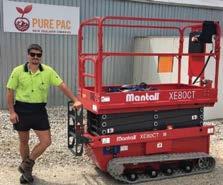



They’d hit their straps and were producing beautiful fruit. I guess I’ll just have to start again
Email: sales@landex.co.nz Ph: 0226 188 456 Orchard Crawler Boom
Self levelling tracked boom 12m height, Lithium/Briggs $83,000 +
Penrose
•
GST ex
The ORCHARDIST : APRIL 2023 13 YOUR INDUSTRY
Tracked
volunteers, Murray and Wendy called themselves lucky to have one dry room, where they installed a borrowed bed, and a new pump so they had water.
Once that was done, however, it was time to get into the orchard where Murray found a mix of bad news and good.
The bad news was that up to three metres of floodwater had taken out infrastructure like metre boxes and pumps, and ripped through sheds “like a washing machine,” destroying everything from machinery and fruit bins to Murray’s prized collection of five early-2000 Holden V8s and Monaros.
“I was numb for a week after I saw that,” he says. “I’d always thought they were cool and believed that one day, if I worked hard enough, I could have one for myself. Now there is nothing left.”
The good news was that, under the layer of silt and behind shelter belts packed with dead sheep and debris, most of the orchard appeared salvageable, barring Murray’s hectare of five-year-old Yen Ben lemons of which, he says, he was very proud.
“I’ve had a couple of amazing women working with me – one who was hit really badly herself – getting rid of any silt in the trees so we can get some sunlight in there and help the fruit colour up like it should.
“But what really kicked off our recovery was a phone call from Ian Albers – boss of our marketers, First Fresh – who didn’t just say ‘we hope you are okay’, he genuinely and sincerely said ‘what can we do to help?’ Thanks to him, within a couple of days there was a helicopter out here spraying to stop any rot.
“Ian and his team are not just about business they’re good fullas, the lot of them. It’s times like these, when the shit hits the fan, that we are reminded of that.”
After allowing time for the ground conditions to permit harvesting, undamaged fruit from the leastimpacted blocks was picked after a month in the sunshine, and time will tell if other, yet-to-mature crops will be suitable to harvest, Ian Albers says.
“Murray and Wendy are fantastic growers and definitely bore the brunt,
so we’re going to be behind them all the way,” Ian added.
“In general, however, citrus is particularly robust and we were early in the growing season so most of our around 100 growers have come through the cyclone well.

“And though there are some challenges in the export space, domestic prices for citrus over the summer have been the highest we’ve seen for 15 years and those returns have brought renewed optimism in our sector of the industry.”
Cyclone Gabrielle was not the first time the Burgess’s orchard, Blue Willow Citrus, has flooded.
“We’ve had a couple of small ones, which is all part of farming, but this one she was a bitch,” Murray Burgess says.
“At my age (56) I am too young to retire and too old to take orders from anyone else, so we’ll keep banging away as best we can.
“But we have this new phrase in Te Karaka, “rain anxiety,” so no doubt that will give us a few sleepless nights in times to come.”
It’s getting rid of all the rubbish that is taking the time
14 The ORCHARDIST : APRIL 2023 YOUR INDUSTRY
Murray Burgess was picking limes by mid-March and looking forward to mandarins in May, with fruit tested so far having been free of contamination
Presenting a worthy heir to the F3015. A genuine concentrate of technology, the F3020 Electrocoup builds on its highly respected predecessor’s technical base adding new and improved features.
Safer, lighter and easier to handle than the previous generations, the F3020 once again demonstrates why INFACO is the leader in electric pruning technology.


Available in F3020 STANDARD
F3020 MEDIUM
F3020 MAXI
Ergonomic design
DSES cut prevention
Safety System
High cutting capacity
Save labour and increase efficiency Learn


Settings button
Removable cover DSES Wireless Conductive trigger
Available from
Brushless motor
One piece rack blade
more
Hard decisions facing Northland avocado growers
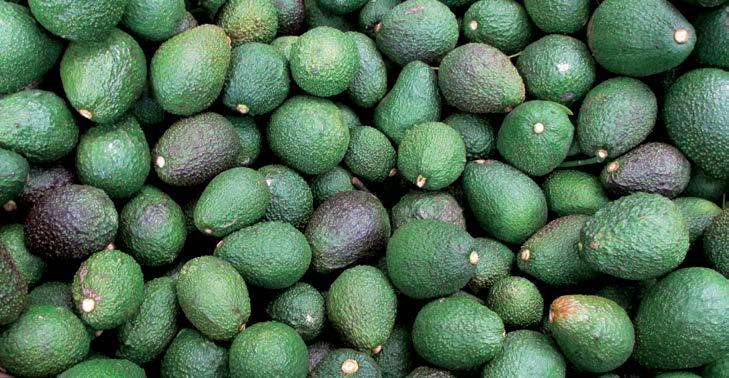
Hopes for a good upcoming season have been dashed for Northland’s avocado growers. HELENA O’NEILL talks with Mark Rolland about the impacts of Cyclone Gabrielle on his orchard near Whangārei.
Tucked in the side of a hill near Maungatapere sits Mark Rolland’s retirement project: his avocado orchard. Mark bought the 6.5-hectare property eight years ago, later buying a neighbouring property of around the same size. He now has 7ha planted in avocado trees.
“The cyclone went through our top blocks and took out a lot of our shelterbelt. We’ve lost about 30 to 40 avocado trees overall. It’s knocked us around, two cyclones in two years. This year’s returns are very, very low due to the cyclone last year which caused a lot of fruit rub and so forth. We’re probably 50 percent down from the previous year.”
After a tough two previous seasons, Mark had high hopes for a bumper crop, only to suffer significant cyclone damage on his orchard.
“We had probably our best fruit set ever, and we’re down to 15 to 20 percent left of fruit. You just don’t know because every time you look you see more dead ones hanging off the tree, and then you’ll see a tree with rather good fruit on it.
“We normally export about 80 percent of our fruit, but the last two years no. We’ll be down to about 30 percent this year with the wind rub and the markings.”
Mark says avocado orchards across Maungatapere have been hit hard by Cyclone Gabrielle’s ferocious winds.
“I went to Maungatapere and I’ve come past an orchard just off the main road and everything is going brown. I hadn’t really noticed how bad the windburn was. I think it’s a good year for pruning.”
Before the cyclone, he had around 1400 avocado trees.

FEATURE ARTICLE COVER STORY 16 The ORCHARDIST : APRIL 2023 YOUR INDUSTRY
“There are still trees falling over. You go through and you still see branches that are damaged. It’s going to take weeks to really sort out everything.”
With two poor seasons set to be followed by low returns this coming season, avocado growers are feeling the pressure.
“There are so many people around here getting desperate, who don’t know what to do, no incomes. Some are like me on the later side of life, and you can’t just go out and get jobs to supplement it.”
“There’s a feeling around here that clonals aren’t producing what they should do in their third, fourth, and fifth years. A lot of those just fell over. It’s frustrating.”
The Northland Rural Support Trust has been really supportive, Mark says and assistance from the Ministry for Primary Industries helps but isn’t enough to make the future less daunting.
Northland Rural Support Trust chair Michelle Ruddell says the trust’s mission is to ensure rural communities are supported. The branch covers from the Auckland Harbour Bridge to the Far North, so it’s a diverse area.
“Our collaboration dinners have been strategically along that west coast where it’s been most affected, up and down the
Kaipara. Avocado growers that we know of needing support are in the Maungatapere area. With them, it’s been phone support and then getting some of them on the list to have [Enhanced] Taskforce Green to come in with the clean-up.”
Enhanced Taskforce Green provides funding to councils or other authorised agencies to employ jobseekers to assist with clean-up activities following an adverse weather event or natural disaster.
The council or agency ensures the workers are adequately trained and supported to complete the tasks and have the necessary tools, equipment and clothing to do the tasks that are required.
As for Mark and his fellow avocado growers in Maungatapere, each day reveals a little more of Cyclone Gabrielle’s effect on their orchards, raising more questions about their future in the industry.
“I was at a discussion group, and we were all in the same boat thinking what the heck will we do?
The number of orchards that are for sale in this area now; there’s more for sale every week. Everyone is reaching the same conclusion: if you had a dying business, you would do something about it or get out of it.”
An
protection material
A proven low-pressure method for control of damaging insects, pathogens and nematodes.
To find out more visit: www.avoject.co.nz or contact us on: info@aaltd.co.nz
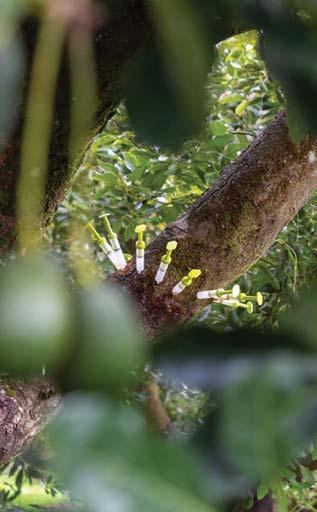
effective tree trunk injection tool for delivering plant
The ORCHARDIST : APRIL 2023 17 YOUR INDUSTRY
Grey nomads loving the lifestyle
There’s a rising pool of older New Zealanders combining travel around the country with seasonal work in horticulture. ANNE HARDIE speaks to orchardists to find out how these ‘grey nomads’ are helping to alleviate labour shortages.
For the past 11 years Lucy Tindale and Kevin Beams have been trans-Tasman seasonal workers, and now they are working three days a week through the apple and kiwifruit harvests.
Working alongside them on Thomas Bros’ Orchard near Riwaka are Brent Hovenden and Jo Daniel who have been travelling the country with their campervan as seasonal workers for 12 years and have become regulars for many growers.
They are part of the sizeable group of seasonal workers generally known as grey nomads who make up a reliable part of the workforce to get the crop harvested.
For Lucy and Kevin, the lure of combining travel and work prompted early retirement for Kevin, and they headed to Australia where they bought a motorhome and hit the road. They gave themselves two years, liked it so much and never stopped.

Initially they picked cherry tomatoes and then moved between the north and south of Australia to avoid the winters, getting work wherever they went. When Kevin turned 65, they returned to New Zealand to ensure he did not lose his pension. They went on to spend six months either side of the ditch each year, until finally selling their motorhome over the Tasman last year and staying put here.
When they were heading back to Australia each year for seasonal work, the Australian Government gave them up to $2,000 each to cover their expenses, plus Kevin received some pension as he paid tax. Then they got their tax back because they had worked only part of the year. They felt they were well looked after in Australia. In comparison, they struggled to get back into New Zealand when Covid-19 forced them into a lottery for quarantine at the border, and Kevin lost his New Zealand pension for a while as they attempted to get back.
FEATURE ARTICLE 18 The ORCHARDIST : APRIL 2023 YOUR
INDUSTRY
Kevin is now 74 and they are still loving their lifestyle, which they say keeps them fit and they get to meet people from around the globe. But they are taking it easier, hence the three days of work a week.
“The labour shortage is good for us because three days a week is perfect,” Kevin says.

“They know we’re going to turn up to work each day,” Lucy adds. “We don’t want full-time because we don’t have to, and that seems to work here.”
Their boss, Steve Thomas, is quite happy to be flexible and employ grey nomads three days a week because they are a reliable pool of workers, and perfect to fill the labour gap each year.
“Ten percent of your staff take up 90 percent of your time. With these guys, it doesn’t matter if they only work three days if you don’t have to spend time nursing them, and they have a lifetime of experience behind them as well as a good work ethic. It rubs off on those around them.”
Steve says a lot of jobs in horticulture are not permanent positions that attract younger people, and they need a large number of people to harvest the fruit. Older Kiwis help fill that gap.
“You have these people who want to do the work without needing it to lead to a future career. It works well for
BRING OUT THE BEST IN THE BLAST
both parties. They’re perfect to fill that gap, and we have a position for them for a few months and they still get to travel around and do their thing.”
Lucy and Kevin are in the packhouse, three days on and four days off, which supplements their retirement earnings and enables them to do things without dipping into their savings.
They own a lock-up-and-leave house in Motueka, but in the past few years they have spent more time in their motorhome in different parts of the country – or Australia. After the apple harvest in Tasman they are hoping for a job on an indoor vertical strawberry farm near Foxton, which they reckon might suit them nicely through the cooler months. While they would never consider picking strawberries on the ground nowadays, vertically grown and indoors is right up their alley.
Like Lucy and Kevin, Jo and Brent are also regulars on Thomas Bros Orchard each harvest. Jo has worked there for 22 years “on and off,” and this season she is in the packhouse grading fruit while Brent is on a forklift.
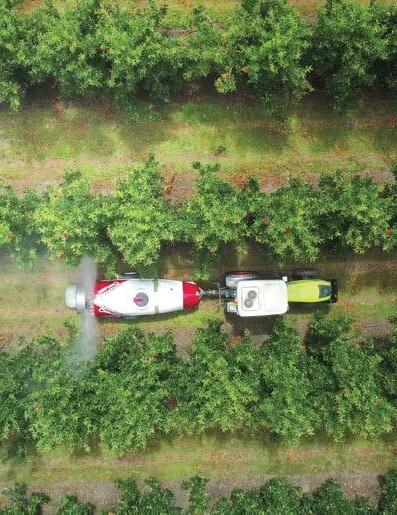
“I’m getting older now so they’ve given me a sit-down job,” he says.
They are some of the younger grey nomads working on the harvest. Twelve years ago they decided they were not going
CROPLINER SLIMLINE Shaped for minimum crop interference 920MM LINEAR TOWER High accuracy in narrow plantings Freecall 0800 106 898 | Email sales@croplands.co.nz | croplands.co.nz Take
HIGH
your operation to the next level with a new orchard sprayer from Croplands. Contact
your
local Croplands or Fruitfed Supplies rep to find out more.
PERFORMANCE FANS FOR HIGH-PERFORMING GROWERS.
The ORCHARDIST : APRIL 2023 19 YOUR INDUSTRY
to wait for retirement to get on the road and change their lifestyle. They were in their 50s when Jo raised the idea.
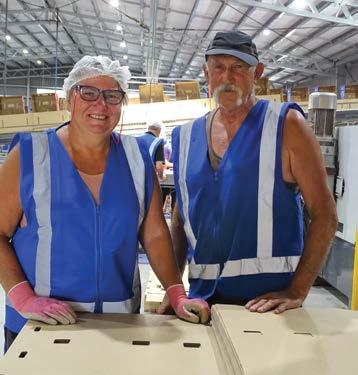
“It started when I bought a little hippie house truck and I said, right, I’m hitting the road and do you want to come?”
They were also planning on a couple of years travelling and taking on seasonal work, but enjoyed it too much to stop. They have regularly headed to Central Otago for the cherry season and to pick other stonefruit. They have picked grapes at Bannockburn and propagated them near Blenheim, as well as the more unusual work with lily bulbs. Along the way they worked at the meatworks at Mataura, adding up to variety and experiences they would not have had if they had stuck with one job. People have been one of the big attractions of the lifestyle and they have met a diverse mix from ‘mongrel mob to midwives.’
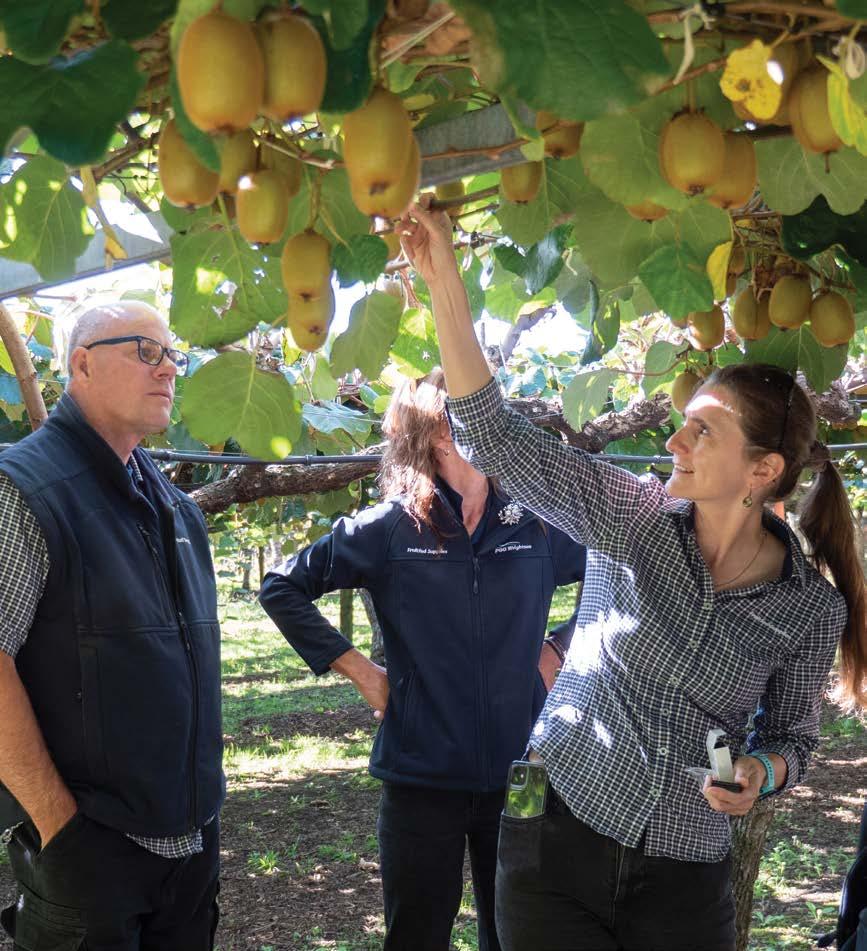
Finding jobs has been easy. Brent says they always worried about finding their next job but it has never been a problem. “There’s work everywhere if you want to work. You just have to turn up to work every day.”
They have found younger workers around them are not always welcoming of the older generation. Younger employers can have the same attitude, and Jo says that can make it harder.
“We can outwork them,” Brent says. “But they often don’t think we should be there.”
They have been on the road long enough that they know
where they want to go back to, and those places are where they are looked after well. At Thomas Bros’ Orchard, they have a mown lawn for their campervan in the ‘village’ where the Recognised Seasonal Employer (RSE) scheme workers also have their accommodation. Toilets, showers, laundry and kitchens make it easier, even though they are basically a home on wheels. It is easier using on-site facilities than having to pack up their home and head to a dump station on a regular basis to get rid of waste.
On a cherry orchard in Central Otago, their boss carved out a platform at the top of the hill so they could park away from the noisy youngsters in their vans, with a view as a bonus. They like workplaces where they can park up with power and facilities, rather than use nearby campgrounds which can be expensive. They still pay some rent to cover water and power when they park up on site. One time, they teed up a job in Ashburton, only to find the camping grounds were full with people who lived there permanently.
“You keep going back to the same ones out of loyalty and because they’re good places to work,” Brent says.
“It’s like family reunions at some,” Jo adds. “There’s a cherry place that asked us back to the Christmas they put on for their workers and their families. That was even after we left.”
Jo and Brent say most grey nomads they meet are travelling short-term for the novelty, but they have loved their long-term nomadic lifestyle and highly recommend it.
“You just have to take a leap of faith to do it,” Jo says.
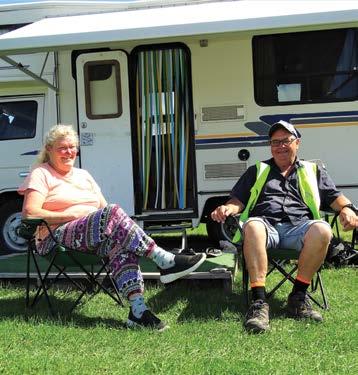 Jo and Brent’s home on wheels for more than a decade
Lucy and Kevin are in the packhouse this year
Jo and Brent’s home on wheels for more than a decade
Lucy and Kevin are in the packhouse this year
20 The ORCHARDIST : APRIL 2023 YOUR INDUSTRY
Lucy, Kevin, Jo and Brent are regulars on Thomas Bros Orchard each harvest
Strengthening the future of horticulture through innovation

The Fruitfed Supplies Research and Development team delivers independent trials designed to measure a product’s efficacy and fit within a crop management programme.

Bringing innovative solutions to New Zealand, these local trials provide growers with products that are backed by reliable in-field data and new tools that support the continued production of quality fruit.

We know horticulture




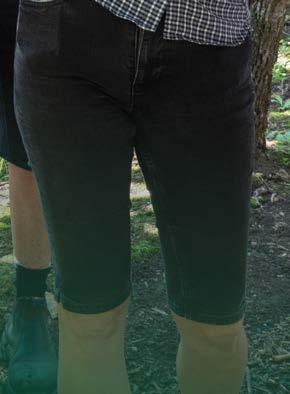
fruitfedsupplies.co.nz
A trading division of PGG Wrightson Ltd
Family values are key for Darling Group
Andrew Darling’s passion for horticulture may have been born on a kiwifruit orchard, but it’s avocados and citrus that Darling Group is now known for. HELENA O’NEILL looks at Darling Group and its vertical integration strategy.
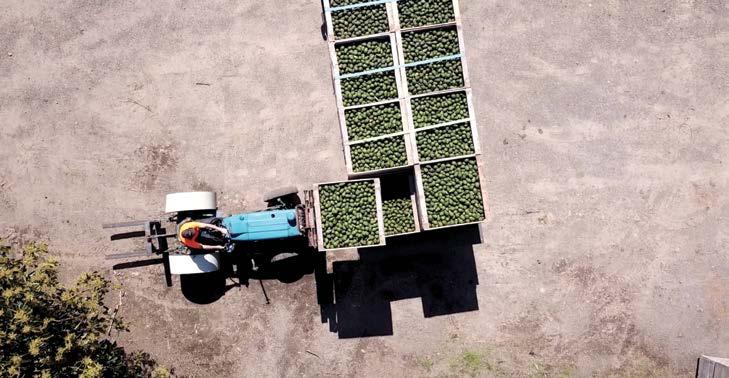
“We are a grower. We are an orchard production specialist. We are a packer. We are a marketer. We are fully invested and integrated into the entire avocado supply and margin chain,” Andrew says.
Darling Group is 100 percent New Zealand owned, with family roots. Andrew Darling, managing director, says they have a background in horticulture coupled with in-depth industry knowledge driven by a passion to deliver high-quality fruit to the markets and superior returns to growers.
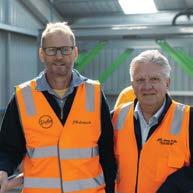
“I’ve been a kiwifruit and avocado grower for quite a long time. Now we probably have a grower base of around
120 contracted growers for packing and exporting services. As of today, about 50 percent of our supply and throughput is from our own properties, from the Darling family and syndicated properties.”
Andrew’s passion for horticulture began in 1983 while working in a kiwifruit orchard and packhouse. In 1989 he purchased an interest in a fruit packing facility in Katikati, and in 2016 created Darling Group which is now made up of a fresh produce export business (Darling Group Marketing), an avocado packhouse (Just Avocados Ltd), a produce wholesale and logistics company in Brisbane (JH Leavy & Co) and a domestic produce marketer (Zeafruit). Darling Group also
Freshly picked avocados arriving at the Just Avocados packhouse in Katikati
FEATURE ARTICLE 22 The ORCHARDIST : APRIL 2023 YOUR INDUSTRY
owns its own orchards as well as having an interest in other orchards. It also owns the orchard management service company Avoworks.




“Historically we were Bay of Plenty-centric, with that comes an element of risk around alternate bearing with avocados, seasonal alternate bearing as it varies from region to region. We’re now across all regions in the Far North, midNorth, and Bay of Plenty. Our citrus is Gisborne-based.”
With orchards spread across the North Island, the business was hit by heavy rain in late January as well as Cyclone Gabrielle.
“We were impacted across all regions … we were expecting to be heavily impacted in the North and in the Coromandel, we did have significant wind events, but the rain wasn’t as bad as what we had in November. We came through with relatively minimal damage.
suffered moderate damage. A yellow sticker means that access to your building is restricted, and it cannot be used, or you cannot enter except under supervision for a limited time or on essential business.

Another property leased by Darling Group suffered secondary flooding after the cyclone when the council drains were filled with silt causing back-flooding, he says. “One of the biggest challenges for the avocado industry is that the short to medium-term viability as a grower is questionable. That’s largely around the alternate bearing nature of the industry and the low production of orchards.”
The avocado industry is made up of many small lifestyle orchards, and the average size is around 2.2ha, Andrew says. “In terms of viability, the long-term future is around lifting the production, managing costs more tightly, and extracting premiums from the market. It’s also about new growing systems, science and technology, and scale. Our industry going through a period of time where we will see some rationalisation, like most other primary sectors at various points of their evolution.
“However, we have an orchard at Tapora on the Kaipara Harbour, it’s 50ha, and it was really knocked around by the tail end of the cyclone. We lost approximately 500 trees blown over or sitting in water, that’s 500 trees out of 24,000. That was reasonably significant. We’re still looking at the crop loss which could be as high as 25 percent on that orchard.
“Outside of avocados, we were heavily hit in Gisborne. We had one [citrus] orchard which went under a metre and a half of water and significant silt at one end as deep as 300mm. We had crop loss, no tree death but we’re frantically trying to get the silt out.”
The house on that Gisborne property was yellow-stickered by the Gisborne District Council, indicating that it has
“It’s gone from a cottage industry some years ago to a serious horticultural export earner for the country. The industry is shaking itself down in terms of what’s sustainable in the future.”
Andrew says Darling Group’s Just Avocados packhouse is “avocado-centric”.
We had one [citrus] orchard which went under a metre and a half of water and significant silt at one end as deep as 300mm
“Our difference is that we only process avocados across our machine. This provides unique features in handling avocados such as water baths, bin tips and automated


The industry is shaking itself down in terms of what’s sustainable in the future
0800 735 859 www.bdmax.co.nz See the website for HortResearch report 10264 & 9 years of grower experience. Available from Farmlands & Horticentre. Excellent results to -2°C
• Provides internal warming more compact flowering • For use on fruit tree crops • The “spray on” that adds to all other methods • Good results have been achieved when applied through irrigation lines
ThermoMax
The ORCHARDIST : APRIL 2023 23 YOUR INDUSTRY
Frost Protection
Hass avocados go through the washer at the Just Avocados packhouse in Katikati
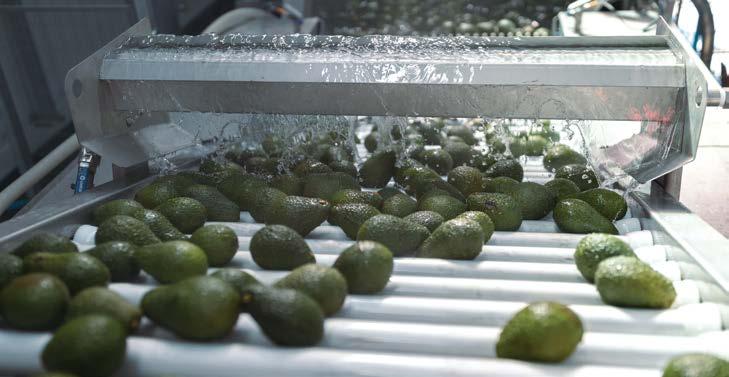
grading, which will enhance the quality and out-turn performance in the marketplace.”
As for Darling Group, they are looking at mechanisation each time they do something, looking at efficiencies of a one-pass operation, and technologies to streamline costs.
“Labour is a big one for blueberries. It’s hard work and it’s hard to get the number of people that you require. We’ve just trialled a new mechanical harvester from Europe, and that’s the future in that space because harvesting is the single-biggest cost with blueberries.”
Andrew says they will be looking to change growing systems and varieties to ones that better suit mechanical harvesting.
“There’s a lot of learning to be done with blueberries.”
Andrew says the Australian arm of the business (JH Leavy & Co) sources, conditions, stores, sells and distributes the best fruit and vegetables from Australasia and beyond. They handle a range of fruit and vegetables through that facility along with their own avocados, citrus and blueberries.
Darling Group has orchards across all regions in the Far North, mid-North, Bay of Plenty and Gisborne
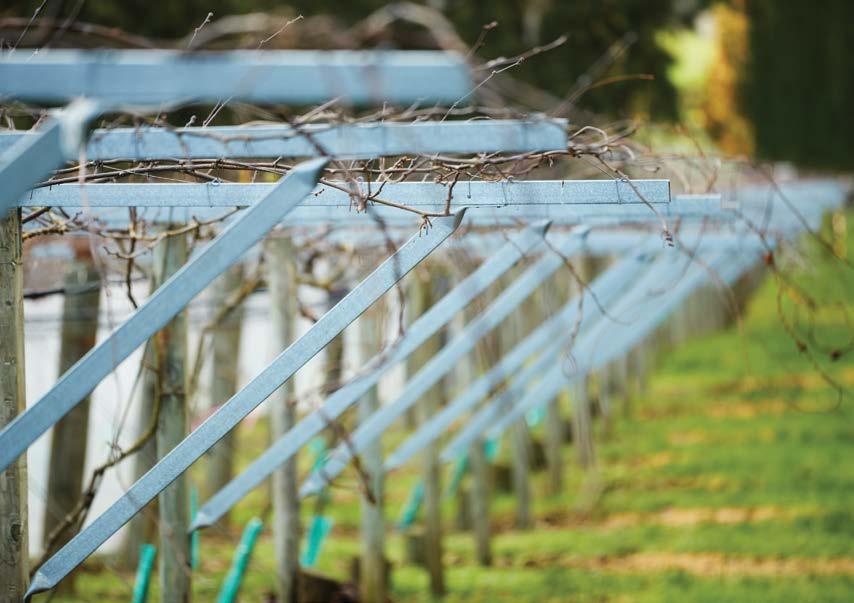
“It provides a significant point of difference with our competitors. We receive our own fruit; the cool chain is not broken from end to end, and it provides a bit of advantage around time and quality.”
Last month Andrew’s son Jacob replaced outgoing JH Leavy & Co chief executive Ben Bartlett who is stepping away from the business to focus on his health after battling CKD (chronic kidney disease) for over a decade. Jacob leaves his role as chief operating officer of Darling Group where he took on oversight of the company’s New Zealand avocado supply and packing business, Just Avocados, while also still maintaining an active involvement in international sales and marketing.
It really is a family business, Andrew’s wife Jo “is the glue to our family”, with her management of the home blueberry orchards just one aspect of her key involvement. Their other son Nathan is employed as general manager of Avoworks (Darling Horticultural Services Ltd) an orchard management, orchard development and horticultural contracting services specialising in orchard production. While not a family member, Andrew says chief financial officer Doug Gordon has been instrumental to Darling Group’s business planning, working with Andrew since 2000.
“I think we’re unique in the New Zealand avocado industry of being able to say we are a grower as well as covering the whole supply chain. We like to think we have instilled the family values all the way through our organisation,” Doug says.
We receive our own fruit; the cool chain is not broken from end to end, and it provides a bit of advantage around time and quality
24 The ORCHARDIST : APRIL 2023 YOUR INDUSTRY







KIWIFRUIT STRUCTURE SOLUTIONS NZ made steel products | Proven reliability | Labour efficient | Built for growth Call Mike 07 282 1538 | agsteel.co.nz AG-BEAM AG-SUPPORT POST AG-Steel Product Range AG-TRIPOST AG-STRINGING POLE AG-BRACE
Tairāwhiti regional response on the ground
Kristine Walsh
There is a sense of déjà vu for Bill Thorpe and Trevor Lupton who, 35 years ago, assisted with analysing the impact on Gisborne’s horticultural industry of the ravages of Cyclone Bola.
This time, their work is in response to February’s catastrophic Cyclone Gabrielle. And this time they have fellow consultant Elliot Callender on board.
The trio have been appointed by the economic development arm of Trust Tairāwhiti, which was nominated to co-ordinate the overall response by East Coast MP Kiritapu Allan, the recently appointed Regional Disaster Lead for Tairāwhiti and the Bay of Plenty.
Working across all orchard and growing product groups, Bill Thorpe says their work will inform government about the impacts on current and future harvests, while creating a base of information to support what recovery assistance is needed most, and by whom.
“For most growers it will be business as usual, while some will have to start again from scratch, or will have very limited or no crops for the foreseeable future,” says Bill. “So our primary focus will be on the number of affected hectares; what crops we can expect compared to precyclone predictions; and what growers need in terms of post-cyclone actions.
Bill, Trevor and Elliot are in touch with Ministry for Primary Industries (MPI) director-general Ray Smith, Cyclone Gabrielle Recovery Taskforce chair Sir Brian Roche, and independent commissioner for Tairāwhiti, Te Rau Kupenga, to ensure their work best serves the community they represent.
“Our job is to make sure the cyclone consequence for the horticulture sector is fully and accurately reported,” Bill Thorpe says. “This will assist government in determining appropriate support for growers.”

For his part, Ray Smith flew to Tairāwhiti and Hawke’s Bay in early March to view the damage first hand, and meet with
Bill Thorpe, together with Trevor Lupton and Elliot Callender, have been appointed by Trust Tairāwhiti to inform government about the impacts of Cyclone Gabrielle
farmers, growers and organisations supporting the food and fibre sectors.
The director-general says that bird’s-eye view of the scale of the devastation was sobering, but valuable in informing MPI’s work.
“MPI has had significant involvement in the effort to respond to Cyclone Gabrielle, and we have a continuing role to help the recovery.
“It’s also important to note that all major primary sector groups, businesses and processors are also doing their best to support their people and members. For example, we are part of daily meetings with Horticulture New Zealand to ensure a co-ordinated approach and information sharing across affected regions.”
MPI has staff on the ground in affected areas – with three key regional control centres in Northland, Tairāwhiti, and Hawke’s Bay – to provide support and advice to help affected farmers, growers and whenua Māori owners get back on their feet as quickly as possible.
The same day Ray Smith made his flying visit to Tairāwhiti, on 7 March, the Ministry announced a $26 million boost to the grants programme helping farmers, growers, and whenua Māori owners to re-establish their businesses in the wake of Cyclone Gabrielle.
That brought the total to $51 million available as firstresponse grants, in addition to $4 million to help with urgent primary sector needs not being met by other organisations.
26 The ORCHARDIST : APRIL 2023 YOUR INDUSTRY
MetService recorded rainfall at the automatic station at Gisborne airport


Trust Tairāwhiti has appointed a team with a two-pronged approach to gather data in Gisborne/ Tairāwhiti








Liaising with product representatives like Zespri, NZ Apples and Pears, and the NZ Buttercup Squash Council, who have been undertaking their own investigations.




Conducting a survey targeting more than 170 growers to identify how they have been impacted, what effect that will have on their 2023 harvest, and what they expect to see in the months and years to come.


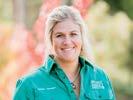

1 2 REGISTER TODAY VISIT WWW.SUMMERFRUITNZ.CO.NZ FEATURING
Te Radar Te Radar Matt Whiting Matt Whiting Harriet Bremner Harriet Bremner
William Pike William Pike
Confirmed sponsors at time of design and print. 47.0 mm 144.2 mm Jan Feb 2022 322.3 mm Mar 1988 Cyclone Bola 251.5 mm 425.1 mm Jan Feb 2023 Cyclone Gabrielle The ORCHARDIST : APRIL 2023 27 YOUR INDUSTRY
Livia Esterhazy Livia Esterhazy
CONFERENCE PROUDLY SPONSORED BY
2.5x YOUR INDUSTRY
RAINFALL
MetService records from the Gisborne airport weather station have registered the wettest January on record since 1937, and with the help of Cyclone Gabrielle, the wettest February as well, says meteorologist John Law. That means in January and February of 2022, that part of te Tairāwhiti – on the border between the city and the Poverty Bay Flats – received just 28.3 percent of the rain that fell in the same months of 2023.
Near half of the total for February 2023 – 195.8mm, or 46 percent – fell on 13 February, the night Cyclone Gabrielle hit the region. The rainfall for that night alone was just over a quarter more than the total rainfall for February the year before.
In the months of January and February 2023
Tairāwhiti received a total of 676.6mm of rainfall, 485.4mm (over 2.5 times the volume) more than in the same months the year before.
And those aren’t even the big numbers. The heaviest rainfall – sometimes more than twice that recorded at the airport – is seen in the ranges around Gisborne,
away from the main horticultural growing areas. MetService acknowledged that due to outages, the airport station had missing data between 10pm and midnight on 13 February, and some missing through the following day.
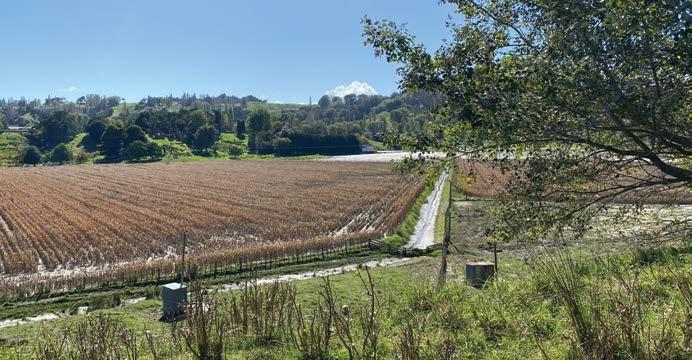
However, comparison with a neighbouring station on the Poverty Bay Flats showed only about 30mm had gone unrecorded. That neighbouring station recorded rainfall of 256.2mm for January 2023 and 454.7mm for February 2023, a total of 710.9mm for the two months combined.
Locals have said that the 12-hour intensity of Cyclone Gabrielle meant it was even worse than Cyclone Bola which, after unleashing three days of rain on the Gisborne region from 7 March 1988, was considered one of the most damaging cyclones to have hit New Zealand.
Figures recorded at Gisborne airport by the then NZ Meteorological Service (supplied by MetService) show rainfall of 322.3mm in March 1988, 102.8mm less than the 425.1mm recorded for February 2023.
Crops affected by the cyclone halfway between Te Karaka and Gisborne
In the months of January and February 2023, Tairāwhiti received over 2.5 times the volume of rainfall than in the same months the year before 28 The ORCHARDIST : APRIL 2023
Hybrid autonomous vehicle developed in NZ wins favour in US
Autonomous multi-use agricultural vehicles designed and built by Robotics Plus in the Bay of Plenty are operating in North American orchards and vineyards, following a successful launch at the International Forum of Agricultural Robotics (FIRA) in California in October.
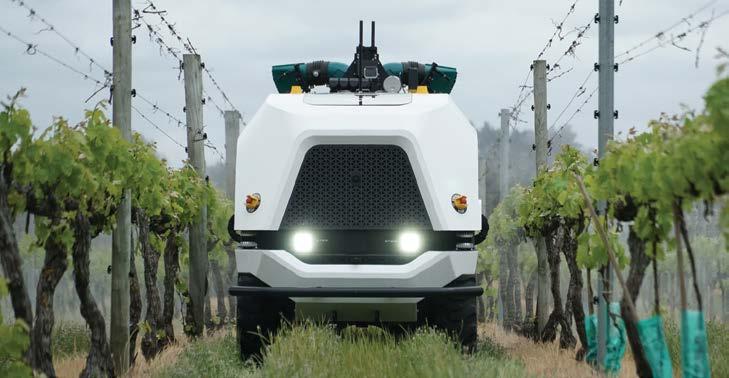 Elaine Fisher
Elaine Fisher
“We were really pleased with the response our Unmanned Ground Vehicle (UGV) received at FIRA,” says Robotics Plus co-founder and chief executive Steve Saunders.
The UGV attracted much interest for its innovative design as a multi-use modular vehicle and because it is a hybrid.
Steve says the horticultural industry isn’t ready for allelectric vehicles yet. “People loved our hybrid design because it enables the UGV to operate for extended periods without the need to recharge.
“One big North American orchard operates 296 tractors. If they were all electric, just imagine what its charging station parking lot would look like. If the tractors were operating implements, they would need recharging every three to four hours.
“Our hybrid UGV has a Tier 4 diesel generator and all it does is generate electricity for the electric drive motors.”
The vehicle uses a range of technologies, including LiDAR (light detection and ranging) and vision systems to sense the environment and to optimise tasks, including the intelligent and targeted application of inputs such
The ORCHARDIST : APRIL 2023 29 YOUR INDUSTRY
This Unmanned Ground Vehicle developed by Robotics Plus was launched in California in October
as sprays. Growers will be able to rotate multiple tools on the platform for tasks such as spraying, weed control, mulching, mowing and crop analysis.
While the UGV costs more than an orchard tractor, Steve says it saves labour costs and improves efficiencies. “A fleet of ten of these vehicles could be operated by just two people; one using a tablet to monitor the fleet from a ute or office, and another person to drive a nurse truck to replenish the spray tanks or remove obstacles should the UGV encounter any in the orchard.
“For our first commercial release of 20 machines in 2023, we will be working closely with key customers to manage the UGV’s integration into their operations before we scale up production.”
A fleet of ten of these vehicles could be operated by just two people
Steve says the machines, which represent the fifth generation of autonomous vehicles designed by Robotics Plus, will eventually be available for New Zealand growers.
“North America is likely to be 75 percent of our market.
We have focused on solving technical problems in the global agricultural industry to create the scale needed to build efficiencies, so we can then offer these solutions to New Zealand growers at appropriate price points. We are
super proud to be doing this in New Zealand, and design, manufacturing and pre-assembly of the UGV will continue to happen here.”
Robotics Plus has strong partnerships both in New Zealand and the United States. “We have been able to test a couple of our machines on a Hawke’s Bay vineyard before trialling them in vineyards in Napa County so we can learn about the different environmental challenges the machines will need to meet.”
The Robotics Plus team of 104 people worked alongside growers, researchers and best-in-class technology suppliers to deliver the unique modular design for the multi-purpose UGV.
The innovations behind the machine have been informed by Steve’s own experience as a grower and horticultural contractor, and by working closely with growers in New Zealand and the United States.
“We have been building relationships to understand the pain points the industry is facing and find solutions which make economic sense in terms of return on investment. One of our customers in the United States is a fifth-generation grower with 10,000 acres of apples. Working with these clients to solve problems is about trust and partnership.”
Robotics Plus has been working to develop robotics for the horticultural industry since 2009 when Dr Alistair Scarfe, co-founder and chief technology officer of Robotics Plus worked on an autonomous kiwifruit harvesting machine as his PhD project from Massey University.

 Dr Alistair Scarfe, co-founder and chief technology officer of Robotics Plus
Dr Alistair Scarfe, co-founder and chief technology officer of Robotics Plus
30 The ORCHARDIST : APRIL 2023 YOUR INDUSTRY
Robotics Plus co-founder and chief executive Steve Saunders
“We could see the pain points ahead for the industry, including labour, and decided to invest in the future –which isn’t normally done well in New Zealand. We tend to wait until the pain point becomes big enough before looking for solutions. Those solutions take time to build.”
Alistair says the hybrid electric diesel UGV delivers outstanding performance. “Electric drive motors give superior torque and control, while the diesel generator means the vehicle can operate for extended periods. Fuel consumption is minimised by electrically driving all systems, including tools. Regenerative braking and highcapacity batteries also extend efficiency and range.
“The vehicle’s lightweight design and intelligent all-wheeldrive system, with independent wheel motors to ensure grip and control, significantly reduces ground compaction to protect the soil,” he says.
The first application for the technology is intelligent spraying, a system which varies the flow rate to ensure spray efficacy while reducing inputs.




The highly manoeuvrable UGV has a small footprint and unique steering configuration, incorporating electric steering and independent motors, which increases productivity, allowing significantly more ground to be
covered than machines which turn on every second row or greater, depending on row configuration. The UGV can be deployed in a range of applications in various crop types with a minimum row spacing of 1.8m (6ft).
The vehicle has been designed from the ground up to be modular and easy to service. With no hydraulic, gearbox or differential fluids to be managed, operators can easily keep their vehicles running if a part fails by simply swapping out modules when needed. All of this is designed to reduce downtime and complexity for growers.
Robotics Plus has partnered with best-in-class technology suppliers, including Yamaha Motor Company, Autonomous Solutions Inc, and Croplands, to significantly increase the robustness and support for the product in a demanding environment such as agriculture.

We could see the pain points ahead for the industry, including labour, and decided to invest in the future
The ORCHARDIST : APRIL 2023 31 YOUR INDUSTRY
Labour and ships return to Tasman for harvest
Tasman’s apple season is delivering good fruit that is flowing smoothly out the packhouse door and onto ships this year, though growers are not shouting from the rooftops when they know fellow growers around the country have suffered so much.
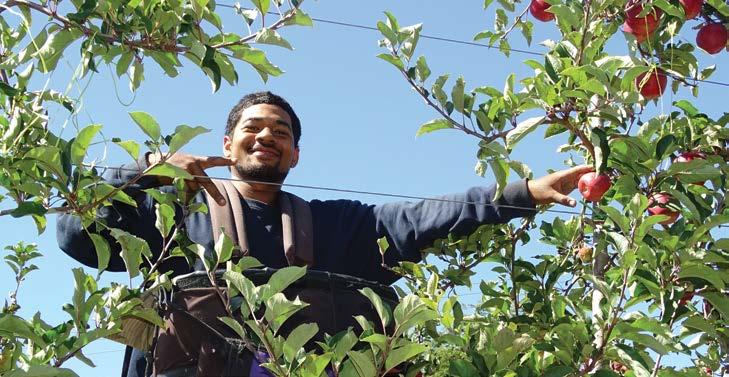
ANNE
HARDIE
reports from Thomas Bros’ Orchard and Thawley Orchard.
On Thomas Bros’ Orchard near Riwaka, Steve Thomas says many of the pressures of last season have eased, especially labour and shipping. Even the markets, which are hard to judge, are showing signs of positivity compared with last year, he says.
Combined with fruit that is good quality at harvest, with size and yield on the high side, growers are both relieved and optimistic. In the early stages of the harvest, a large crop of good quality gala apples came off the trees.
Kiwifruit also, with the first SunGold harvested in midMarch, is shaping up well and despite the hard October
frost that hit the country, achieving relatively good pollination which has resulted in a large crop. The same frost wilted the new leaves on the apple trees, but the crop held. Through the season the region has had more rain – but nothing to complain about – so less irrigation was needed and there was plenty of sun without high temperatures.
The shortage of apples and kiwifruit in the country this year means demand will increase for the Tasman fruit and Steve says there will be growers in financially marginal positions who will get through this year. But he says there is an uncomfortable feeling around good fortune when seen in
FEATURE ARTICLE 32 The ORCHARDIST : APRIL 2023 YOUR
John Samie from Tonga surrounded by bright red DazzleTM apples at Thawley Orchard
INDUSTRY
relation to drastic events in other parts of the country. As fruit is harvested it is also getting onto ships, which is another relief. Shipping fruit from Nelson has been a nightmare through Covid-19 disruptions as vessels missed the port completely to make up time. This year, so far, Steve says shipping problems seem to be sorting themselves out.
“We don’t have any additional coastal vessels which was our problem, but the nature of the game with less lockdowns means they won’t be skipping Nelson to make up time. Fruit has been moving early; fruit comes into the packhouse and goes out, into the container and is gone.” It has been a while since that happened in Nelson and he says it is a huge relief for growers and the industry. Shipping rates have also dropped significantly. Through the Covid-19 shipping problems, costs rocketed by 100 percent and Steve says it looks as though it may drop back 75 percent of that increase, which would be “massive.” But in mid-March, it is still early days and a lot of fruit has yet to get on a ship to markets around the world, which is another unknown.
“The worry is the varieties harvested for European markets will have a lot of competition.”
Countries such as Austria that have opted not to sell fruit to Russia are now putting that fruit into the European markets. Though that fruit is Northern Hemisphere and not competing directly with New Zealand’s season, Steve says it still affects the shoulders of our season and that brings down the average price per carton, which can have a big impact.
Last year EnvyTM apples were selling for $45 a carton early on, but Steve says it ended up about $32 a carton and the cost of production was about $28 a carton. Most premium
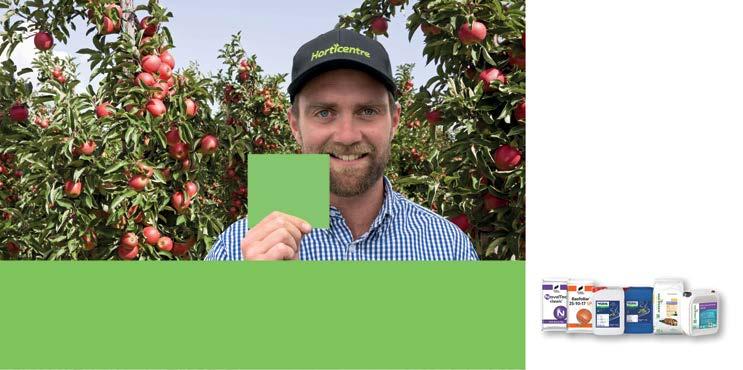
varieties had “massive drops” last year and he says that is a concern to growers.
Asian markets are looking more positive this year due to less Southern Hemisphere fruit being harvested, and combined with lower shipping costs to those markets, returns for those varieties are promising, he says.
Growers know they need to spread their risk in as many ways as they can, but Steve says that is an ongoing process that takes years to implement and the markets change faster.
On labour, this season has been a huge relief compared with last year when there were challenges getting Recognised Seasonal Employer (RSE) scheme workers into the country on time, including delays following Tonga’s volcanic eruption. Plus, the Working Holiday Visa workers were still absent because of Covid-19 restrictions.
“You really notice the Working Holiday Visa (WHV) shortage when RSE workers are delayed by three weeks. This year is almost like a relief. Last year was a hard year. We were really scraping the bottom of the barrel last year and barely had enough workers to get the job done properly. We were doing all we could to get all the fruit in the box and couldn’t put in that extra attention to detail.”
Though the WHV workers are back this year, Steve says there are probably still not as many as in the seasons before Covid-19. Another reason he suspects there are plenty of workers for this year’s harvest is the weatheraffected crops in the North Island which has likely driven workers south in search of work.
“We have enough workers around now that we have a wait list. I don’t think anyone is really screaming out for workers. We’re still taking on as many Kiwis as there are looking for work, but if it was just Kiwis we wouldn’t have enough.”
The ORCHARDIST : APRIL 2023 33 YOUR INDUSTRY
Heritage plums increasingly popular in recent years
Aimee Wilson
When Craig and Georgie Affleck moved to Pisa near Cromwell almost 10 years ago, the only thing you would find on their 12ha lifestyle block was dust and rabbits.
The former sheep and beef farmers from Southland decided to move north and make a better life for themselves and their three children, away from the relentless grind of caring for animals.
Planting cherry trees, like many other growers in the Cromwell basin, was an obvious first choice, but they also decided not to put all of their eggs in one basket.
Craig had grown up eating greengages through spending time with his grandparents, and when they moved from Riversdale to Central Otago, not many people were growing them.
“We were always told you should plant what everyone else is ripping out,” Georgie joked. There is something nostalgic about greengages and they are certainly making a resurgence around New Zealand, particularly over the past three years.
The well-known Jackson Orchards down the road sold out all of their pre-orders this season three months before they even came off the trees in February.
Jackson Orchards sent about one tonne of greengages to customers around the country, with 80 percent of their orders heading to the North Island.

Central Otago now has at least 11 growers – from the Teviot Valley right through to Cromwell.
Webb’s Fruit, Darlings Fruit, Suncrest Orchard and Freeway Orchard also grow greengages in the Cromwell basin, along with Hobbs Family Partnership Orchard in Roxburgh East, Coal Creek Gardens, Dam View Orchard and Johnson’s Cottage Orchard and Fruit Stall. HJ Roberts in Earnscleugh has been growing the English variety for decades.
The plums are a low input fruit with a good return. The Afflecks have planted a total of 300 greengage trees of the
traditional English variety and also the Reine Claude de Bavay from France – both are quite different in appearance and flavour.
The English variety is smaller with a red blush, is bursting with flavour and produces as much juice as a peach. It’s as sweet as a lolly but with a slight tang. The French greengage is a brilliant lime green with more flesh inside, but with a less pronounced taste.
“The green colour defies expectation, it’s sweet and delicious,” Georgie says.
Such is the growing popularity of this fruit that you now have to order trees from the nursery well in advance, and Craig and Georgie plan to plant a further 50 on their orchard next season.
The first few seasons they only managed 300 to 400kg of the fruit, which wasn’t enough to sell domestically, so they just concentrated on local markets – and their greengages were soon snapped up.
This season they have managed to produce 2.5 tonnes of the English variety and a further 1 tonne of the French variety – which are distributed to Fresh Direct and sold mostly to the North Island markets.
Greengages love shelter and can mark easily from the wind when they are young, but now that their trees are a bit older they are starting to protect themselves.
They are also more tolerant of frost than cherries, however a grower in the Teviot Valley this season lost their entire crop in the snow event of October 2022. Unfortunately for
Georgie and Craig Affleck of Pisa near Cromwell with their French plums
34 The ORCHARDIST : APRIL 2023 YOUR INDUSTRY
the Hobbs Family Partnership Orchard, the snowstorm and frosts wiped out the greengages, but many of their other plums have been popular, with online orders coming from all over New Zealand.
Tram Road Fruit Farm 35km north of Christchurch is another grower of heritage plums, including greengages, but unfortunately a severe frost in October wiped out this year’s crop as well.
Owner Paul Tapper says because greengages have a long flowering season, “a hard frost just blows them to bits.”
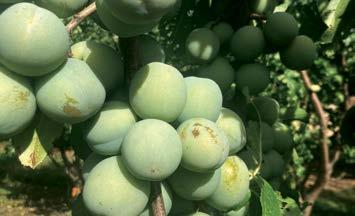

Which is why the Afflecks haven’t just concentrated on one specific fruit since they established their orchard ten years ago. As well as greengages, there are also raspberries and olives, and 150 feijoa trees that grow fruit up to the size of avocados.
Georgie grew up in the North Island, and when she moved south her mother used to send her Easter eggs and feijoas in April every year. Since she relocated up the road to Wanaka, her daughter now returns the favour.
The raspberries and feijoas are also sent to Wanaka to make gelato for a local business in the tourist lake town, and once the olives mature more Georgie and Craig will start producing oil for commercial use as well.


The couple have totally embraced their new life and have loved starting from scratch and learning something new.
“We have the worst soil, but with the right nutrients and a lot of hard work you can get things to grow,” she says referring to the rocky, stony, dry paddocks surrounding them.
“We used to say if you find a worm it’s a champagne day. Now we have more worms and less champagne!”

GREENGAGES THROUGHOUT THE AGES
Known as Reine Claude in France after the Duchess of Brittany, it would appear the English ‘greengage’ name we know has come from the Reverend John Gage who managed to introduce the plums into England around 1724 from the Chartreuse Monastery.

The green and yellow plums with a rich sweetness, which could almost be described as “confectionery sweet,” were also a favourite of American Presidents George Washington and Thomas Jefferson.

Sadly the trees did not thrive in the United States climate and lost their appeal. These days greengages are imported into the United States (and parts of Europe) from right here in New Zealand.
As we all know, in the fruit growing industry ultimately everything stems from a twig. We have alliances with some of the world’s best new fruit variety developers and rootstock breeding programmes. These relationships and our continual search for the best cultivars puts us at the forefront of global variety and rootstock development in New Zealand.


Our unique capability across a wide variety of crops and our focus on matching varieties and rootstocks to conditions allows us to offer real, informed advice. Call:
Kate Marshall, 0274 201 033, kate@waimeanurseries.co.nz

Jeff Sandford, 0274 201 003, jeff@waimeanurseries.co.nz
www.waimeanurseries.co.nz
In our world of twigs and roots pedigree is everything.
The ORCHARDIST : APRIL 2023 35 YOUR INDUSTRY
Eve’s degrees prove ‘literally’ ideal for horticulture
A career in horticulture wouldn’t appear the logical choice for someone with degrees in English literature and a minor in French literature.
Elaine Fisher
However, Eve Williams, Pathways Into Primary Industries (PIPI) lead at Primary ITO, is a shining example of the truism that there are careers for everyone in horticulture, no matter their background.

“My Master’s degree may seem very irrelevant, but my philosophy is that university is a chance to learn indiscriminately, rather than worrying about what is useful,” says Eve, who is also a founding member of Women in Horticulture.
The analytical and research skills Eve developed during her university studies have stood her in good stead in her industry roles. After completing her degree at Victoria University, Eve enjoyed a six-month OE before returning to New Zealand to join the natural resources team at Horticulture New Zealand.
“After two years I moved into a policy analyst and business manager role for NZ Asparagus Council and four years ago joined Primary ITO.”
Although Eve grew up in the Wairarapa, she had little connection with horticulture. It was the fact that HortNZ is a levy funded organisation, working for growers, which prompted her to apply for that first job. However, it was sitting in a NZ Asparagus Council board meeting which really brought home the passion growers have for their crops.
“We had been talking about how heavy a good spear of asparagus should be for 20 minutes when I realised that everybody loved what they did. I knew then why those people were in the room, and I was pleased to be on the ride with them.
36 The ORCHARDIST : APRIL 2023 YOUR
Eve Williams – Women in Hort
INDUSTRY
“What really spun my wheels at HortNZ was managing Young Grower of the Year and the Recognised Seasonal Employer (RSE) and horticulture conferences. ‘People’ is my jam, so when I saw a role at the ITO, whose raison d’être is developing capability for the primary sector, I was super keen to move into this area.”
Primary ITO has now joined Te Pūkenga, New Zealand’s largest tertiary education provider, and Eve says unifying classroom and workplace learning will make it much easier for people to progress within the industry. “It’s also important that industries have a strong voice in how education and qualifications are delivered.”

Eve was involved in the research behind the establishment of the Pathways into Primary Industries (PIPI) programme, designed to facilitate the attraction, recruitment and retention of Kiwi talent into New Zealand’s primary industries. One of the challenges the primary industries face is reaching people who have no connection with the sector and letting them know about the great training and career opportunities on offer.
“The horticulture sector has shown it is possible to pivot to meet the needs of staff, including structuring shifts to fit around young families, and other measures to attract different people to the industry. There is also so much innovation that roles are continually changing and there are opportunities from the farm or orchard to the supply chain to international markets. It’s a big story to tell but once we get the stories out there, they tell themselves.”
Eve, who lives in Masterton, often works from there, commuting to the Primary ITO office in Wellington on other days.
Tending her vegetable garden and fruit trees and making sweet treats for Good Bitches Baking is how she likes to relax.
“I’m regional co-ordinator for Good Bitches Baking Wairarapa chapter and we have 80 bakers and drivers. Our kaupapa is to make sweet treats for people who are going through a hard time. There are 30 chapters in the whole country (and not all bakers are women).
“The Wairarapa chapter supports 13 different recipients including a day shelter, Hospice, Women’s Refuge and a teen parent unit. You don’t have to be a master baker to be involved, because it’s the kindness in your intentions that matters more than the final product.”
The horticulture sector has shown it is possible to pivot to meet the needs of staff


And about that literature degree, focusing on how women were portrayed in 18th century poetry: “It was pretty dire. That was the time when printing presses became more common and almost anyone, including women, could publish without the previous gatekeepers. This was a threat to the patriarchy and many anonymous ‘advice tracts’, supposedly written by women, but more likely by men, on the pitfalls facing women who strayed outside the norms of society were published.”
Eve says there are parallels with today’s social media through which anyone can publish opinion, with no arbiters of quality or standards.
On the other hand, the place of women in society today is starkly different from the 1700s, as evidenced by the number of women in every aspect of the primary industry, including in leadership roles.
“The more representative the leadership and influencers of the industry are, the better we will be able to represent the people that make up the industry and ensure that the decisions made reflect all facets of it,” says Eve.
To keep up to date with Women in Horticulture, its news and activities, and join the membership database, email info@women-in-hort.nz

Everyone is welcome.



HAVEN DISTRIBUTING COMPANY LIMITED 7E Orbit Dr, Rosedale, Auckland 0632 • PO Box 924, Whangaparaoa, Auckland 0943 Ph: +64 (9) 213 3024 • Email: sales@havennz.com • www.havennz.com
RSE WORKER ACCOMMODATION BUNKS, BEDS, STORAGE & MATTRESSES
The ORCHARDIST : APRIL 2023 37 YOUR INDUSTRY
Haven Commercial is focused on design, quality manufacturing, and full safety compliance on commercially rated bunks & beds, in steel or solid timber; proven over many years supply to Seasonal Worker [RSE], Backpacker, Holiday Park, Boarding school & University accommodation facilities. Buy directly from Haven Commercial’s manufacturing supply chain, with the ability to respond quickly to specific requirements of RSE accommodation providers.
Young horticulturalists look to the future after Cyclone Gabrielle
In Hawke’s Bay the horticulture sector needs young growers more than ever. Far from disheartened, the next generation believes in new solutions, as BONNIE FLAWS discovers.
“The devastation is probably larger than what we were initially thinking it was,” Brittany McCloy tells me.
The young horticulturalist normally works for Apatu Farms as a labour strategies and solutions manager, but has been seconded to Hawke’s Bay Vegetable Growers Association to do work assessing the impact of Cyclone Gabrielle on the region’s vegetable crops.

“The amount of horticulture businesses and employment that sits in the geographical area of the flooding is immense. A lot of businesses are in a tough
situation and have to make decisions about how they will continue.”
In the first weeks after the storm, Brittany’s time was targeted at contacting growers to determine the extent of their losses. Now, she’s part of a grower task force working to inform the government of how vast the damage has been.
“I think government are very much in the same boat as us in trying to understand how severe the impact is and what the tangible things are that are needed for recovery,” she says.
 Brittany is one of a cohort of young people working in
Brittany is one of a cohort of young people working in
YOUNG GROW ERS 38 The ORCHARDIST : APRIL 2023
Damage to infrastructure such as the Brookfields bridge makes container deliveries to port or picking up bins and delivering them to the packhouse chaotic
horticulture in Hawke’s Bay who will be integral to the sector’s recovery and rebuild. The 26-year-old is clearly a passionate professional, who speaks with confidence and clear commitment to the job, despite only having been in the Bay for a year.
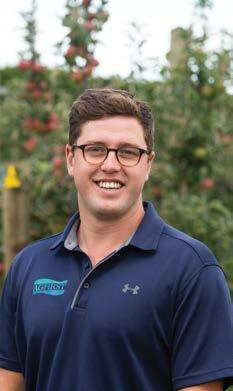

She says what growers need most right now is certainty of government support. The diversity of operations that have been affected and the range of impacts are vast – no two cases are the same she says.

Some growers are finding it really hard to think about how they will pay employees or whether they should continue to invest in clean-up costs when they don’t know if they will be able to recoup any of that. To date the primary sector has been allocated a total of $51 million for the initial recovery, but this isn’t enough given what growers are facing, she says.
“Without certainty of whether or not government will offer some form of support how does a business make decisions and how does a bank have confidence in that business,


especially the worst impacted who may not have any harvest left to salvage, or may have lost capital expenditure such as orchards that they would need to rebuild?”
The recovery of the sector hangs on this question. There is plenty of will to build back even stronger than before, and with the right support growers could even improve their systems and integrate more forward-looking production systems, she says.
Brittany remains committed to horticulture, despite the hard slog ahead, and says there are opportunities for young growers. In fact, for young people interested in a career in horticulture, now would an excellent time to get in.
“All these orchards are going to need to be redeveloped and that is a really cool process to be a part of, and if you are a young person who’s keen as, there’s heaps of opportunity there. Equally with maintaining those properties long-term and moving towards management type roles.
“If you are a young person who’s keen as, there’s heaps of opportunity there.”
Brittany McCloy
“It reinforces that this is the place to be as a young person.”
Jack Wilson
“When you have a blank canvas people are more willing to try new things.”
Article sponsored by The ORCHARDIST : APRIL 2023 39
Kurt Livingston
“It may not be what some people thought they were getting in for, but crisis breeds innovation and the ability to think differently. [Young people] don’t necessarily have the baggage of the past and can think differently about problems that growers have faced for the last 20 or 30 years.”
Rebuild opportunities
On the export and sales side of things, 28-year-old Kurt Livingston of Fern Ridge Fresh, says the season has really cranked up as fruit growers try to salvage what they can. Around 80 percent of orchards still need to be harvested, and have suffered varying degrees of damage.
“But you have to get what you can out of them, as growers need the income. The market has been pretty tough for the last couple of years and this was not needed. In most cases our growers were alright in areas not affected by river floodwater or major silt. The best thing to help them with was get on and sell their fruit.”
The company normally exports around 700,000 TCE (tray carton equivalents) a year, but this year volume will obviously take a hit.
Shipping is still a mess, and getting produce exported in a timely manner has been tough. For about ten days after the storm there were no boats in and out of Napier Port, and packhouses were without power. The company’s logistics plan changed dramatically as they were forced to truck apples up to Tauranga instead of Gisborne, and across another really dodgy storm affected road.
“Damage to the infrastructure all over Hawke’s Bay has made it a real challenge to get around. The bridges not being operational makes container deliveries to port or picking up bins and delivering them to the packhouse chaotic. We have growers all around the region and in all areas.”

I think there will be a lot more innovation and adoption of new technologies moving forwards. When you have a blank canvas people are more willing to try new things
Despite all this, Kurt says he’s more passionate than ever. He’s found it heartening to see the industry come together as a community to support each other and volunteer on each other’s clean-ups. Even the Nelson growers reached out to Hawke’s Bay and sent up diggers to assist.
“It is going to be a really challenging next few years as the industry faces rebuild, so mentally everyone needs to be prepared for that, but we have some great people in the industry who are driving that positive energy and there are still some amazing opportunities.
“I think there will be a lot more innovation and adoption of new technologies moving forwards. When you have a
40 The ORCHARDIST : APRIL 2023 YOUR INDUSTRY
Kurt Livingston of Fern Ridge Fresh says getting produce exported in a timely manner has been tough
blank canvas people are more willing to try new things. But this will come at huge cost. Not everyone will want to take on this big rebuild.”
Kurt says there’s likely to be some natural attrition in the aftermath as growers grapple with the costs of getting back to where they were. There will be at least a ten-year period of cleaning up, redevelopment and waiting for new trees to come into full production.
New science from disaster
AgFirst horticultural consultant Jack Wilson works in the area of precision agriculture, and will likely be involved in introducing some of those new technologies as they come online.
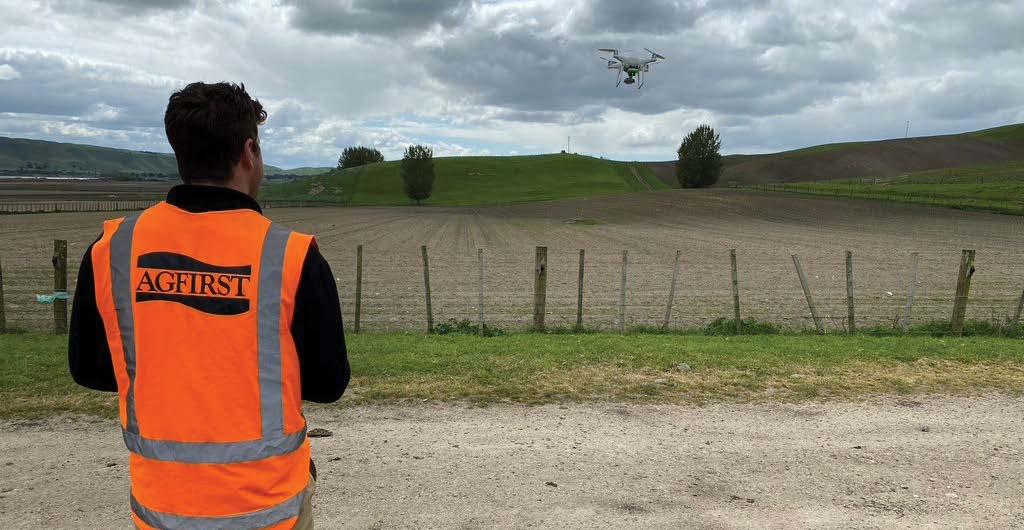
“I deal with a lot of trial work, testing a whole lot of theories that growers have or we might have, and then I do a whole lot of consultant or project work,” the 27-year-old says.
“All of that continues for the most part, but I suppose [since the storm] there has been another element in our role which is assisting growers affected by floods, looking at silt levels around trees.
“We are figuring out that a lot of these growers are having similar issues but going about it differently, so a lot of our work has been around consolidating those ideas and finding efficiencies, as well as assisting them with technical advice around the tree’s physiology.”
In fact, Jack says there is a lot of new science coming out of this disaster, particularly around the role of silt and how
it can stress the tree. These new understandings can be applied in any future flooding situation.
He sees part of the role of young people in the future will be to bring in new technologies and science that will increase productivity, while also keeping in mind the vulnerabilities that the flooding laid bare.
“The importance of that just becomes higher and higher. You know, a young brain is quite often a fresh brain, so bringing all of that sort of information will really benefit the industry.”
But he’s also learning a lot from the existing leaders within the industry, whose resilience he says is amazing.
“The attitude is very much ‘this has happened so let’s get on with it and keep going as quickly as we can.’
For someone in my position that’s relatively new in the industry, it’s great, because it reinforces that this is the place to be as a young person. There is so much to learn from these people with that attitude, doing a job as difficult as this.”
Call
Online Orchard Irrigation Supplies
AgFirst horticultural consultant Jack Wilson says there is a lot of new science coming out of this disaster, particularly around the role of silt and how it can stress the tree
our experts 0800 130 905 www.irrigationexpress.co.nz
The ORCHARDIST : APRIL 2023 41 YOUR INDUSTRY
Plant Pass biosecurity –increasing resilience and trust
Elaine Fisher
Registrations for Plant Pass, the new voluntary biosecurity certification scheme for New Zealand plant producers, have so far exceeded expectations, says Matt Dolan, chief executive of New Zealand Plant Producers Incorporated (NZPPI).
Seventy-four producers are now registered under the scheme launched last year to recognise good biosecurity practice and provide assurance for plant buyers.

The aim is to have 110 producers registered by 2024. There are approximately 200 commercial nurseries in New Zealand of which 150 are NZPPI members, representing about 80 percent of the plant production sector in the numbers of plants being produced.
Worldwide there has been a focus on the importance of biosecurity practices in nurseries, which has led to the development of biosecurity schemes in Australia, Europe, Canada, the United Kingdom and United States. Plant Pass is New Zealand’s version of these standards.
“Taking a proactive approach to biosecurity helps to protect New Zealand’s economy, unique natural environment and way of life,” Matt says.
Plant Pass is a certification scheme that recognises plant producers who demonstrate an understanding of the practices that support plant health and have met the Plant Pass standard. It also provides assurance to customers that plants have been protected and raised using the practices that support good biosecurity.
“It takes a systems approach to biosecurity to increase resilience and trust. Protecting plant buyers and producers enables safe movement of plants and drives associated economic, environmental and social benefits to New Zealand.”
The structure of the Plant Pass scheme is similar to the GAP (Good Agricultural Practice) programmes that operate in other parts of the horticulture industry. The scheme
consists of a core (generic) standard and checklist which covers hazards common across a wide range of nurseries, plus measures and guidance to help manage the risks. Key elements include training, hygiene, crop protection, monitoring and traceability.
“Our goal is that Plant Pass certification will enable nurseries to meet a range of biosecurity standards with a single certificate. It has equivalence with schemes such as the Avocado High Health Scheme (AHHS), Grafted Grapevine Standard and the Kiwifruit Plant Certification Scheme.”
Plant Pass offers specific modules to meet new standards for regulated diseases like myrtle rust and kauri dieback. This is for nurseries supplying native seedlings for forestry and environmental planting.
The Plant Pass website includes a register of the nurseries that are part of the scheme. As Plant Pass is a voluntary scheme it relies on growers supporting the scheme and requesting certification from their seedling suppliers.
Brendan
Gould, chair of the Plant Pass Governance
Molly Shaw (left) and auditor Elena Ellis checking drainage in viola potted colour at Zealandia in Christchurch
Taking a proactive approach to biosecurity helps to protect New Zealand’s economy, unique natural environment and way of life
42 The ORCHARDIST : APRIL 2023 YOUR INDUSTRY
Group and Biosecurity Manager for the NZ Forest Owners Association says the forestry and horticultural industries have a shared interest in the outcomes that Plant Pass offers in terms of reducing the risk of spreading new or already established pests and pathogens through the nursery pathway.
“The ultimate goal would be to have all nurseries participating in the programme and we will strive to meet that challenge. Plant Pass is a voluntary scheme, and it may take some time before we get buy in from the different sectors within the industry from large corporate nurseries to smaller businesses to nurseries run by volunteers growing plants for habitat restoration.
“Nurseries are at the core of all plant-based sectors and if any biosecurity risks do get into nurseries they can spread very quickly, so it’s important that we work to reduce this risk and the potential impacts that they might have.”
Triggered mainly by the outbreak of the fungal disease myrtle rust in New Zealand in 2017, Plant Pass was established after three years of research, and is funded and organised jointly by the Ministry for Primary Industries (MPI) and primary sector industry bodies through the Government Industry Agreement (GIA). The GIA Operational Agreement partners are MPI, NZ Forest Owners Association, NZ Avocado, Kiwifruit Vine Health, NZ Winegrowers, Citrus NZ, TomatoesNZ and NZPPI.
Pass. The schemes achieve an equivalent level of risk management, which gives nurseries options.”
“As a whole, Plant Pass enables a more consistent approach to sourcing plants, which will protect our horticultural crops and our native and ornamental trees.
“KVH sees this as an excellent initiative to encourage biosecurity uptake across a wider range of nurseries at a level comparable to our own effort,” Leanne says.
New Zealand Avocado deputy chief executive Brad Siebert says the industry encourages their growers to purchase avocado plants from Plant Pass certified nurseries. Alongside this, New Zealand Avocado is requiring all avocado nurseries to meet the Plant Pass core standard as a prerequisite for the industry’s own nursery standard (AHHS).
“We see Plant Pass covering everything required for biosecurity risk mitigation in nurseries, making our industry level standard very complementary to Plant Pass. It streamlines the whole process from administration through to reduced auditing costs, and makes achieving good biosecurity more straightforward while providing a higher level of assurance.”
PLANT PASS
Is a voluntary Nursery Biosecurity Certification Scheme
Brendan says that the Plant Buyers’ Accord was established to allow plant buyers to send a clear signal to plant producers of their preference to source plants from certified nurseries. “This would enable them to have greater assurance that any potential biosecurity risks associated with the plants that they buy are being well managed. This in turn will help incentivise plant producers to become certified under Plant Pass.”
Accord signatories to date include MPI, New Zealand Avocado, Kiwifruit Vine Health, Department of Conservation, Auckland Council and Waikato Regional Council. New signatories are expected to come on board in 2023, including plant retailers, other government agencies and sector advocates, and agencies that own nurseries.
Leanne Stewart, chief executive of Kiwifruit Vine Health (KVH) says the kiwifruit industry takes a very proactive approach to biosecurity management. “Last year we introduced the new National Pathway Management Plan (Pathway Plan) which sets out requirements for the movement of risk goods, including plants, which nurseries can meet through certification schemes such as our own Kiwifruit Plant Certification Scheme (KPCS) and now Plant
Is a single system recognising good biosecurity practice and managing the complexity and diversity among plant producers
Provides a framework for end-to-end risk management from nursery inputs, through production, to plant buyers and their environments
Increases plant producer responsiveness to pest threats, before nursery stock is distributed to its customers
Strengthens traceability

Strengthens nursery hygiene measures, pest risk management and establishes certified plant producers as trusted suppliers
For more information visit: www.plantpass.org.nz
If any biosecurity risks do get into nurseries they can spread very quickly
The ORCHARDIST : APRIL 2023 43 YOUR INDUSTRY
Tractor donations helping Tonga recover from eruption
Three fully reconditioned tractors and two sets of disc ploughs have been sent to Tonga to cultivate land smothered by ash from the volcanic eruption of 15 January 2022.

Donated through the Tractors for Tonga programme co-ordinated by the Growers Relief Fund Trust of Horticulture New Zealand, the tractors are a highly valuable addition to the island nation’s existing small fleet of tractors.
“It was Julian Raine (former HortNZ chairman) who masterminded the project following the huge eruption of Hunga Tonga-Hunga Ha’apai volcano last year,” says Mike Chapman, who has been co-ordinating the Tractors for Tonga programme.
“He brought together a group of Nelson growers to buy a tractor and since then other donations have been made.”
Elaine Fisher
A Massey Ferguson 245 was jointly donated by Wai-West Horticulture, Vailima Orchards, Heywood Orchards and Wairepo Holdings. Seeka Ltd has donated a Massey Ferguson 135. Willisbrook Orchards matched funds raised by their staff to purchase a Ford 300 for the orchard’s Recognised Seasonal Employer (RSE) scheme workers and their families on Ha’apai Island.
The tractors have been upgraded and canopies installed by Norwood in Pukekohe. Zespri, through its annual rugby charity auction, donated $5,000, which was matched by Rabobank. Those funds were used to buy new disc ploughs for the tractors. Neptune Pacific Direct Line Pte Ltd has also discounted their shipping costs.
44 The ORCHARDIST : APRIL 2023 YOUR
Massey Ferguson and Ford tractors are ideal for use in Tonga because they are easy to service and parts are available
INDUSTRY
“We are very grateful for the generosity the project has received including from many individuals who have donated funds, and would welcome further donations, including of more tractors,” says Mike.
The Tractors for Tonga programme is working through the Pasifika Safe Shelter Trust in New Zealand and the Ongo Niua Community Corporation (ONCC) in Tonga, both registered charities.
We are very grateful for the generosity the project has received
“We are very fortunate to be working with Peter Rodwell (chair of the Pasifika Safe Shelter Trust) who has close connections in Tonga and an excellent understanding of the needs of the people there.
“As with previous shipments, these tractors and attachments are donated and not for resale in Tonga, and are to be managed particularly for those families who cannot afford to plough their land,” says Mike.
Peter Rodwell says the older Massey Ferguson and Ford tractors are ideal for use in Tonga as they are simple to operate and maintain and spare parts are readily available.
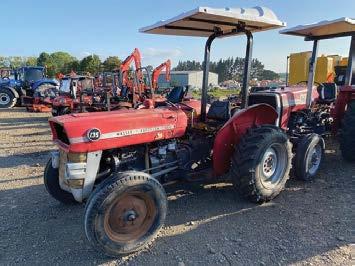
Without cultivation it will be years before anything will grow in the ash
“The Chinese Government and a New Zealand businessman had sent brand-new, high-tech tractors to Tonga but when they break down there is no one with the skills or equipment to fix them,” he says.
Peter says the need for tractors is significant throughout
Tonga. “Much of the work on the land is done by women, as many men are in New Zealand in RSE schemes.”
In order to grow food after the eruption, Peter says the deep layer of ash covering much of the islands needs to be tilled. “Without cultivation it will be years before anything will grow in the ash. Growing their own food is vital because many people are very poor and live in a subsistence culture.”
The Ongo Niua Community Corporation has undertaken to ensure those in most need have the first use of the tractors. “When the tractors are hired, the cost includes the driver’s wages and fuel. If people can’t afford to pay, they will still have access to tractors,” says Peter. The ONCC is currently running tractor driving and ploughing training for women.
To find out more about Tractors for Tonga contact the Growers Relief Fund Trust secretary Antony Heywood: Antony.Heywood@hortnz.co.nz
Donations for Tractors for Tonga can be made through: Growers Relief Fund Inc hortnz.co.nz/about-us/growers-relief-fund
New Zealand Board Associate Director
Horticulture New Zealand is seeking an Associate Director to serve and gain experience on its Board.

The appointment commencing in August 2023 would allow the successful appointee to gain experience in governance, leadership and strategy.
This position will suit an applicant who has active involvement in a horticultural growing enterprise giving an understanding of the issues and challenges that horticulture and growers face.
This is a great development opportunity for a future leader with a genuine interest in governance. The Associate Director will have the opportunity to be mentored by an industry leader and receive governance training.
In making the selection, HortNZ’s diversity policy will be considered.
The job description can be found at hortnz.co.nz/about-us/ work-for-us.
If you are interested in this role, please send your CV and a cover letter to the Board Secretary via email admin@hortnz.co.nz
Applications will close at 5pm, Friday 19th May, 2023, with the successful candidate undergoing induction in July 2023 with their term commencing at the HortNZ AGM on Thursday 3rd August 2023.
Seeka Ltd donated this Massey Ferguson 135 tractor
Horticulture
The ORCHARDIST : APRIL 2023 45 YOUR INDUSTRY
Defying the odds
Supplied : Farmstrong
Eleven years ago, Troy Hall suffered a nearfatal accident on an avocado orchard. A long and challenging recovery followed. Now he’s sharing his story to make sure other horticulture workers ‘grow home safe’.
By his own admission, Troy Hall had a tough upbringing. “It was an underground world of drugs and alcohol and following the wrong people. That was ten years of my life.”
As the pull of that world waned, Troy made a concerted effort to get his life back on track. In 2011, he headed to Tauranga to pick avocados with his father. But less than a month into the job, he suffered a devastating setback. He was electrocuted twice while using a ladder nearby 110kV powerlines on the property. The first shock ‘killed him’. The second jolted him back to life, but left him engulfed in flames.

“I wasn’t expected to survive. I swelled up to six times my size, got through that, but was left paralysed from the neck down.”
The initial prognosis was bleak – Troy wasn’t expected to walk again. But once again, he defied the odds and after years of physical rehab and struggles with depression, he now runs his own avocado contracting business and is in demand as a motivational speaker.
He says a major turning point was the birth of his daughter, now nine. “She gave my life purpose and is one of the main reasons why I decided to share my story.”
In a split second suddenly you’re looking up at a hospital ceiling facing years of physical and mental recovery
Looking back at his accident, Troy recalls, “Like a lot of people, I took life for granted. An hour or two before it happened, I was right beside those power lines and didn’t feel scared at all. My attitude was: ‘nothing could touch me’. I guess you could say I was cocky, arrogant, stubborn. But I discovered life can change in a split second and suddenly you’re looking up at a hospital ceiling like I was, facing years of physical and mental recovery.”
$15 MILLION
In 2021, the sector had $15 million paid out in injury-related ACC claims
Troy Hall says the birth of his daughter was a turning point that helped him defy the odds after his accident
46 The ORCHARDIST : APRIL 2023 YOUR INDUSTRY
It was a hard lesson to swallow. Troy sums up what it taught him in two phrases – ‘self-care and self-respect’.
“When you have both those things, you don’t take your life for granted. Instead, you think ‘hey, I shouldn’t be anywhere near these power lines!’”
Troy admits his former lifestyle was part of his undoing. “When I had my accident, I wasn’t eating well, wasn’t getting enough sleep, wasn’t doing exercise. That all contributed to how I felt. When you’re tired or not eating properly, your decision making really suffers. What happened to me was probably inevitable given the lifestyle I lived.”
The reality is horticulture work can be bloody tough on the body
So now he’s on a mission to pass on what the past 11 years have taught him about the benefits of looking after yourself and your team on orchard. This ties in well with a new initiative launched by Horticulture New Zealand called ‘Grow Home Safe’ which seeks to identify and address key wellbeing issues impacting growers. In 2021, sector had $15 million paid out in injuryrelated ACC (Accident Compensation Corporation) claims. Troy believes there are still many workers in the horticultural sector, and other labour-intensive industries, living like he used to live and at serious risk of accident or injury.
“If I was living the way I used to, I’d still be a complete mess and would never have dealt with what I’ve been through. My recovery has taught me that good sleep, nutrition and routines to keep the body moving all add up to a dopamine kick that helps you get through challenges. For example, what you put into your body is what you get out. If you’re putting good food in, you’ll have a lot more energy and your thinking will be clearer.”
“The reality is horticulture work can be bloody tough on the body. That’s why workers turn to alcohol at the end of the day, because they’re sore. But when you do that for years on end, your body’s never getting proper sleep, it’s not getting looked after properly and you deteriorate to the point where you could be a hazard to yourself or others. I know because I was one of those people and I’m sure there are still plenty of others like I was out there.”
“On a cherry picker you can be eight metres up in the air. If you’re tired and not paying attention, you could easily miss powerlines or things below. I think there are a still lots of near misses in the industry. It doesn’t have to be a traumatic event like I had to put you out of the game or stop you earning.”
Troy is quick to point out that as far as he’s come on his recovery, it remains a ‘work in progress’.

“People who see the ‘before and after’ shots often tell me it’s a miracle I survived, but it doesn’t always feel like that to me. My image, how I looked, was always important to me. Now I’m burnt I’ve had to learn to accept the which at times has been very hard. The gym has been a great escape for not just physically but mentally. I gym every day and try and pump as hard as I can.”
Troy also acknowledges the importance of other people in his recovery. “Surrounding yourself with good people is essential. If you’re doing everything on your own, it’s so much more difficult to deal with negative thoughts going through your head. There’s a lot of people out there who want to help, but you’ve got to take advantage of that. I’m as guilty as anyone of not always doing that.”
Troy says his dream was always to run his own horticulture business. “I’ve always liked what the horticulture industry brings to communities in terms of its fruit and produce. Dad helped me start my avocado business when I was paralysed and now we’ve been going for nine years. The contracting side of the industry’s been up and down lately, so I’ve branched out into sales and am looking to get into the wholesale side. I’m proud of what we’ve achieved. Now I’d like to give something back to the industry and encourage people to take care of themselves.”
Farmstrong asked Troy if he had any advice for growers hit by Cyclones Hale and Gabrielle about how to tackle a major setback.
“I can only imagine how hard it must be for growers who’ve lost everything in the floods. My advice would be, keep yourself busy, surround yourself with good people and don’t waste time worrying about things you can’t control. Just focus on making the progress you can each day.”
The ORCHARDIST : APRIL 2023 47 YOUR INDUSTRY
“My accident is something I’ll have to live with for the rest of my life. For me, it’s been about accepting that, as best I can, and just getting on with things. That’s why I’m so proactive about working on my wellbeing. It’s a great way of keeping busy and keeping your mind off negative thoughts.”

“It’s taken me a long time to learn about self-care and what it takes to have self-care. I was down in the dumps for years. But since I’ve embraced it, I’ve had some great things happen and I’ve slowly learned to appreciate the wins I’ve had. I’ve got a beautiful daughter, I’m running
Grow Home Safe
The Grow Home Safe project seeks to identify and address key wellbeing issues impacting growers. Horticulture New Zealand runs the project, which is predominately funded by ACC through a Workplace Injury Prevention Grant.
a couple of businesses and I’m doing the best I can to help others.”
Don’t waste time worrying about things you can’t control
“I used to look at what happened to me only in a negative way. Now I look at it as something I can share to help people. If my story can inspire others and help them overcome their challenges, great.”
Farmstrong is a nationwide rural wellbeing programme that helps farmers and growers manage the ups and downs of the industry. To find out what works for you and lock it in, visit www.farmstrong.co.nz for free tools and resources.
2011 Now 48 The ORCHARDIST : APRIL 2023 YOUR INDUSTRY
After a bleak initial prognosis, Troy Hall is now in demand as a motivational speaker
Recovering from Cyclone Gabrielle
Kate Hellstrom : Summerfruit NZ chief executive



As we all know, Cyclone Gabrielle has caused widespread damage in a number of growing regions. Many growers in Hawke’s Bay in particular, have experienced crop losses and damage to their infrastructure and in some cases, their homes.
As others have said, it was a postcode lottery. While some growers reported total crop losses, others saw their orchards inundated with water, damaging some trees and infrastructure, and still others were lucky not to have been affected much at all.

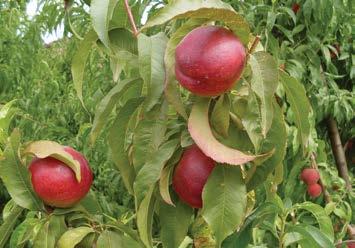
As the event unfolded and contact was lost with many of our growers in Hawke’s Bay, it was a nervous few days for those outside the cyclone zone. The photos and stories coming out via intermittent communications from growers and colleagues were almost too extreme to comprehend.
Now the full extent and impact of the damage is clear. Despite the devastating impact of Cyclone Gabrielle, it has been encouraging to see how growers have shown remarkable resilience and determination, and communities have come together to help with recovery, with support from industry bodies and government agencies.
For a Summerfruit NZ perspective, I encourage growers to continue to refer to Horticulture New Zealand’s updates about how to access support, apply for recovery funding, and for advice about proactive steps to rebuild damaged orchards. In a sense, the summerfruit sector has been slightly more fortunate as most of the summerfruit harvest had been completed in Hawke’s Bay before the cyclone hit. What remains to be seen is how the most affected orchards can recover and what the next harvest season
will look like. Please continue to look after yourselves and those around you – it will take a long time to fully recover from such a severe event.


It’s been an extremely tough time for growers
It was already a difficult season for Hawke’s Bay, with lower sunshine hours and poor fruit-set, so it’s been an extremely tough time for growers. I am encouraged though that the industry has the determination and energy to recover. As effects cyclone, it is clear including summerfruit important of the local economy and community in Hawke’s Bay.
SUMMERFRUIT UPDATE Est 1956 L.E. Cooke Nurseryman Ltd Ltd L.E.
Growers of high quality fruit trees your fruit tree Try us first for requirements! Marty & Kelli Cooke 75 York Road, Longlands, Hastings, 4120 PH: 06 870 7043 EMAIL: lecooke@xtra.co.nz CELL: 0274 396 205 (Marty) Proudly serving the fruit industry for 66 years •Pears •Plums •Apples •Apricots •Cherries •Peaches •Nectarines www.lecooke.co.nz The ORCHARDIST : APRIL 2023 49 YOUR INDUSTRY
Cooke Nurseryman
Good feijoa crop this season but support needed
Ian Turk : NZ Feijoa Growers Association manager


The feijoa season is underway as this column is being written. For our growers in the North Island Cyclone Gabrielle came at very much the wrong time – when the harvest was in sight, and growers had been through virtually the full season of nurturing the crop and incurring cost. One advantage of a wide geographical spread is that there are feijoa orchards outside of the area hit by Gabrielle. However Northland, Auckland, Waikato, Hawke’s Bay and Gisborne cover significant growing areas.
I am aware of growers whose orchards have suffered significant structural damage and have lost crop, or who cannot send fruit to market this year because of food safety issues after the trees have been submerged during flooding. We certainly have these growers in our thoughts and appreciate the support packages that the government has rolled out to assist with the clean-up and protection of capital.
The impacts from Cyclone Gabrielle are going to have an effect for several years across all of horticulture. I’m sure we are yet to fully understand the extent of the damage to soils and structures, and ongoing damage to future harvests from trees that have suffered, or the number of new trees that will need to be planted. Food security is becoming an issue for central government, and we are waiting to see what ongoing support will become available to aid and encourage the rebuild of primary industries. From an industry point of view – we have certainly escaped far more lightly than we could have. There will definitely be a good crop of feijoas available – although total volumes must be down because we know some fruit is lost.
As normal the season will be short – so get them while you can. Early reports are that good tasting fruit of good sizing is going through the packhouses. There may be some fruit that has the odd blemish or funny shape but this will not affect fruit quality.
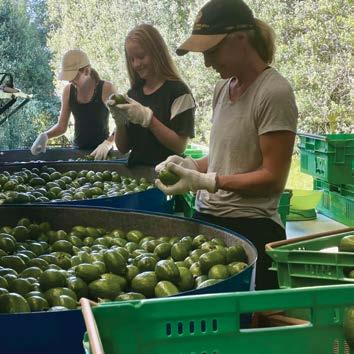
Plant & Food Research principal scientist and 5+ A Day Charitable Trust spokesperson, Dr Carolyn Lister says feijoas provide valuable nutrition.
“Including just two feijoas a day through the autumn months will provide 64 percent of your recommended daily intake of vitamin C, which has an important role in increasing immunity,” she says. “Feijoas are also a source of fibre, which helps you feel fuller for longer and is important for digestive health.”
We are yet to fully understand the extent of the damage to soils and structures
There are plenty of feijoa recipes on the 5+ A Day website (https://www.5aday.co.nz/) that provide many delicious alternative ways to get your feijoa fix. And of course there are many feijoa crumbles to be baked in 2023.
FEIJOA UPDATE 50 The ORCHARDIST : APRIL 2023 YOUR INDUSTRY
Facing the future at the World Avocado Congress
Jen Scoular : NZ Avocado chief executive



Never has there been a more vital time to have a global conversation about climate change, resilience and adapting to change. As The Orchardist hits your doormats, I’m sure many of you will have joined us for a very robust discussion on this at the World Avocado Congress which took place 2–5 April 2023 in Aotearoa New Zealand.
With the devastating impact of Cyclone Gabrielle likely to be felt for years if not decades, we have got no option but to face the future, and figure out what needs to change. We can’t keep doing what we’ve always done and expect a different outcome.
Avocado growers in the Whangarei region were hit hard with wind, tree and shelterbelt damage, and lots of fruit on the ground. It was a very big weather event for many, but most would look at what happened in Hawke’s Bay, Gisborne and Tairāwhiti, and say, boy we were lucky.
As an avocado sector globally there has been a fair amount of negative media, headlines about avocados taking too much water, villages destroyed through deforestation due to the planting of avocado orchards, and chemical use causing issues with water supply. We had Eric Imbert speaking at the World Avocado Congress about this being a critical time when avocado supply is about to overtake demand, and without good promotion to increase demand, the sector will have not have enough markets for all the avocados.
We had Brent Clothier talking about climate change and the impact that may have not only on growing conditions but on the avocado supply chain, on labour availability, and on the availability of land that is suitable to grow avocados.
Lain Jager talked about global trends and how they impact how we might need to grow, ship and market our avocados. Acknowledging the importance of growing nutritional food but the challenges of doing that as well.
All the while, the global population increases and people need to be well fed with safe and nutritious food. We can grow that food, and we do that very well in New Zealand, but are we keeping up with the innovation, technology
and change required to grow food under the new environmental conditions growers are having to face?
We all want to do better for the environment, use less water, less chemistry and be more productive, but are we really investing in science and technology to optimise how we grow, ship and market our produce?
Is policy keeping up with this change, are we creating policy for the future or back-pedalling and creating policy for what has already happened?
My thoughts go out to those whose lives have changed because of a weather event – and my encouragement to all of us to be part of the conversation about how we change to keep up with a changing world.
AVO UPDATE
We can’t keep doing what we’ve always done and expect a different outcome
The ORCHARDIST : APRIL 2023 51 YOUR INDUSTRY
Minimising flood impacts

Page 53
TECHNICAL
THE LATEST INNOVATIONS AND IMPROVEMENTS
Cyclone Gabrielle: “Management of a disaster often ends up more important than the disaster itself”
Cyclone Gabrielle was an unwelcome intruder which, one month ago, worked its way down the East Coast causing destruction and devastation to the horticulture industry during what was already the busiest time of the year on orchard.
Meg Becker : AgFirst Consultants Hawke’s Bay

As we adapt to the new normal, we have gone from responding to a national state of emergency to transitioning into regional recovery. Our attention is starting to shift, allowing us to pick our heads up from the silt, step back and see the bigger picture.
During the emergency response phase, the focus of many Hawke’s Bay and Gisborne growers has been survival –facing management decisions related to Cyclone Gabrielle,
as well as managing business as usual on the crops not affected by floods.
The goal of many growers has been simply to minimise the long-term impacts on their canopies, and harvest as much of the unaffected crop as possible.
NZAPI (New Zealand Apples & Pears Inc.) worked with industry to categorise the damage across the region as quickly and efficiently as possible, to help growers make
The ORCHARDIST : APRIL 2023 53 TECHNICAL
decisions associated with the challenges they face based on the state of their orchards.
Growers had to consider each individual orchard’s needs, make quick management decisions, prioritise actions and focus on the quick wins – with many blocks having limited to no accessibility due to silt deposits, hazards, blocked entrances and roads.
Growers had to prioritise each and every step, focusing on:
1. Their highest potential crop value for this season. Looking across the board and then focussing down to a variety and block level.
2. Potential recovery value for next season and beyond.
3. Dubious or no ongoing potential without major efforts (salvage is physically too difficult or expensive because there is too much silt).
4. People (staff limitations, availability & worker safety).
5. Equipment & infrastructure damage or loss.
6. Harvesting fruit not affected by floods (including quality and suitability).
7. Getting the best information and assistance possible.
8. Ranking the business limitations in order of:
a. Financial situation and overall importance to the business
b. Where you can make a difference
c. Time critical needs of the business limitation
d. Creating an updated orchard specific management plan.
Short term challenges – The month post Cyclone Gabrielle
Many short-term challenges and limitations have now been addressed by growers in the first few weeks following Cyclone Gabrielle. This has had to be done while managing (where possible) the 2023 harvest in incredibly challenging conditions.
There were number of orchards that experienced the full force of stop-bank breaches and sustained damage to the degree that salvage of the block is either not possible or not economical. For these growers the major short-term challenge has been facing the fact that the blocks are unable to be salvaged.
Where blocks have been inaccessible by foot, growers have had to assess damage using helicopter imagery and drone flights. These images were then able to be used to assess for hazards, and where safe to, isolate these to gain block access. The hardest part of this for many, has been closing the gates on the unsalvageable areas and turning their focus to the salvageable orchards.
Oxygenation of the tree root zone
Flood water across Hawke’s Bay had generally receded within 48 hours, although there were still areas reliant on pumping stations (generally challenged due to power outages). Keeping the water moving and oxygenated to prevent it from going stagnant, as well as removal all altogether has been a huge priority in order to provide oxygen to the root zones.
Trees can initiate new roots at soil O2 concentrations above 12 percent. Growth of existing apple roots requires soil O2 concentrations of 5–10 percent, however apple roots die when O2 concentrations are ≤ 3 percent.
Common wisdom suggests that trees under full crop can survive 72 hours under water, however this is highly dependent on the oxygenation of the water and the rootstock the trees are planted on. We have anecdotal and hopeful evidence to suggest that provided the water has been kept moving, trees can survive seven days of flooding, providing a consistent soil profile and unstressed trees.
Silt deposits
Most of the silt deposits across the Hawke’s Bay are largely impervious to air due to having no macropores. Deep silt build-up will asphyxiate trees, lead to root death, collar rots and scion rooting. The deposited silts are very different in texture, ranging from sandy silts to a layer with more clay like a plasticine type (fine textured) material, and at various depths of 5cm up to 1m. The silts showing a greater proportion of sand are more porous and have better potential for air movement, while silt with a greater proportion of clay is less porous and has poor ability to move air.
Within a week, we were seeing broad spread gleying in these smaller particle silts, with trees firing aerial roots (acting as snorkels searching for air), suggesting anaerobic conditions in the root zones.
As the varying silts have been drying out, cracks have been forming, allowing air into the soil profile. As this is happening, we are seeing good worm activity, with castings present in the weed spray strip, and some of the sandier silts showing ant life.
Decision matrices, with information sheets explaining the flood soil assessments have been created in accordance with NZAPI and the industry flood response group in order to assist growers in their silt removal decision making process: www.applesandpears.nz/Floods/Technical_and_ Crop_Advice
The Nelson growers who suffered a similar issue with Cyclone Gita four years ago believe we have four weeks from the time of the storm to remove the deep silt to ensure the tree or vine survives and is able to crop in the following seasons.
Growers have had to make individual calls on each silt affected block, and prioritise where to put their focus, with efforts being put into protecting the highest value, most susceptible plants or rootstocks first. In order of increasing susceptibility: M793, MM106, CG202, M26 with M9 being the most susceptible.
Saturated silts, sitting waterlogged and unable to drain, are currently the most concerning. They are showing little to no signs of cracking. In many cases the waterlogging is exacerbated by reflective cloth acting as an impervious layer in the silt. This is also caused by external drains at full capacity, unable to take on any more surface water.
54 The ORCHARDIST : APRIL 2023 TECHNICAL
Many growers with sumps were unable to run these at full capacity due to power issues, with some in the more badly affected areas still battling with loss of power a month on.
As these saturated silts are at the highest risk of causing tree loss, growers have worked hard to clear water, mostly finding it an uphill battle until the silt naturally begins to dry.
In many of the shallower silt affected blocks the main focus has been on clearing the weed strip with a digger, with a plan to cultivate and mix the silt with the topsoil in the interrow and reseed. To do this efficiently, some growers have repurposed mounding ploughs and agrofers used in the vegetable industry.
In the deeper non-porous silts, growers have resorted to using tracked bobcats to remove the silt from the grass sward out to the headlands. They are then using a small, tracked digger to move the silt from the weed strip into the grass sward, and then bobcat that material out.
Ross Wilson’s What’s App group sparked inspiration and provided a platform for growers to come together to share their struggles and successes in their cyclone recovery.
Harvest planning – business as usual where harvest can continue for fresh fruit or juice
Food safety is a major focus for the Pipfruit industry. Industry advice should be followed regarding what fruit is able to be harvested for fresh consumption.
Prior to harvest, growers are establishing where the fruit can be harvested safely to ensure no contaminated fruit makes it into the bin at harvest.
All fruit bins that had contact with flood waters have to be cleaned down, so they are free of mud prior to harvest. Some packers have offered to do this so growers could return dirty bins and start afresh with clean bins. Preventing
mud splash onto bins and fruit has led to growers retrofitting mud-guards to their bin forks and minimising passes down rows by adapting their harvest plan, all to avoid contamination risks.
Medium term – The challenges we are facing in the present
Progress with silt removal across the region is well underway. Growers have made short-term (and long-term) decisions on blocks, and the immediate actions (if any) that needed to be taken, have been put into motion.
Pest & Disease Management
Crop protection is of the utmost importance. As soon as practicably possible, it is recommended growers get covers on their crops to protect them from rots, cankers and fungal diseases. The better we protect our canopies now, the more likely we are to reduce the levels of over-wintering inoculum.
For the unaffected orchards, the crop protection programme should not change. This should be kept tight, and followed strictly to keep the fruit clean and meet market requirements.


This season European canker incidence has been visually higher in the Hawke’s Bay. This accompanied by the flooding leads us to assume canker monitoring and removal and fungicide covers are going to be really important this autumn and winter.
Alternaria and blackspot have also had a higher than normal presence across the Hawke’s Bay this season. Removing fruit post-harvest and mulching leaf litter to facilitate organic matter breakdown will be a priority this autumn.
Phytophthora is another huge concern this season, not only for the flood affected orchards, but also those that have been sitting in saturated ground conditions for months on end.
Figure 1 Stagnant water unable to drain away
The ORCHARDIST : APRIL 2023 55 TECHNICAL
Figure 2 Flood affected orchard with 30cm silt deposits, showing cracking & worm castings in the weed spray strip
Phosphoric acid is our best form of defence at this stage. It’s important to note phosphoric acid can only be used on the unharvestable (flood affected) crops, or post-harvest. We won’t know the true impacts of phytophthora in the region until spring next year, so we need to do all we can now to lower the potential incidence. The sooner phosphoric acid is applied, the more effective, as green healthy leaf facilitates the translocation of the active ingredient through the plant and into the roots.
Sub-surface water saturation
Once the surface water is gone, the land down to at least 30 cm needs to be drained as quickly as possible to allow the trees to develop fine root hairs prior to leaf fall. This is largely dependent on the effectiveness of the sub-surface drainage network. To ensure that network is maximised:
• Check regularly that sump pumps are operating to their maximum.
• For gravity tile systems, check that all outflows are not blocked.
Where water tables are naturally higher (especially in free-draining soils near rivers), until the water level drops, the ground will remain saturated regardless of the drainage network installed.
Removing flood affected fruit
Fruit that cannot be commercially harvested needs to be removed from the trees as soon as possible. We don’t want a one-year disaster impacting next year’s crop if we can avoid it.

The sooner we relieve the pressure on the already highly stressed root systems, the sooner we can optimise the rate of photosynthesis to drive vegetative and root health. This will enhance the fruit bud quality for next season’s crop and prevent the risk of biennial bearing.
Replenishing the trees’ reserves using post-harvest nutrition should be carried out as soon as practicable. For the accessible non-harvestable crops, now is the time to do this as the trees are still photosynthesising before they begin their natural senescence and drop their leaves.
Natural plant ethylene levels are incredibly high. Blocks that have been under water for significant lengths of time are showing signs of natural fruit abortion.
For blocks that aren’t doing this naturally, there are options that can aid in assisting fruit removal:
• Removal of fruit by hand or using sticks – expensive.
• Shakers (either handheld or mechanical such as those used in the juicing industry) – dependent on availability and skill.
• Ethephon (Ethin, Ethrel).
Note: Ethrel will place the tree under additional stress. If you believe your trees are already under significant stress with silt or flooding, it is important to consider this when selecting the best fruit removal option for your block.
Ideally once the fruit has been dropped to the ground it should be mulched. This will aid the breakdown of inoculum infected fruit material. It is important that fruit is dropped onto soil rather than deposited silt, as the microorganisms in soil assist in the breakdown of organic matter.
Scion rooting
Aerial rooting is the tree’s reaction to a lack of oxygen in the root zone, where roots form above the scion (above the rootstock union).
Where silt deposits are above the union, they will have to be cleared – and with more urgency where aerial roots are already firing.
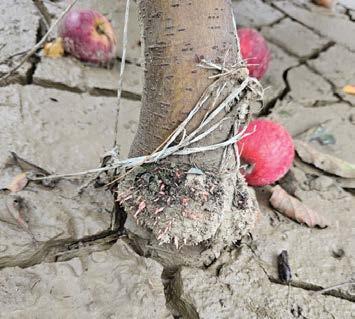 Figure 3 Flood affected fruit
Figure 3 Flood affected fruit
56 The ORCHARDIST : APRIL 2023 TECHNICAL
Figure 4 Aerial roots forming, acting as snorkels for the trees suffering highly anaerobic conditions
Scion rooting is a serious problem, as it eliminates the dwarfing characteristics of the rootstock, resorting back to the vigorous, low yielding characteristics of the scion.
Blocks with very shallow silt, where the rootstock shank is still visible are less of an immediate priority (especially orchards at higher elevation with better drainage). These could be addressed later (e.g. after harvest or when drier in autumn).
The goal of many growers has been simply to minimise the long-term impacts on their canopies

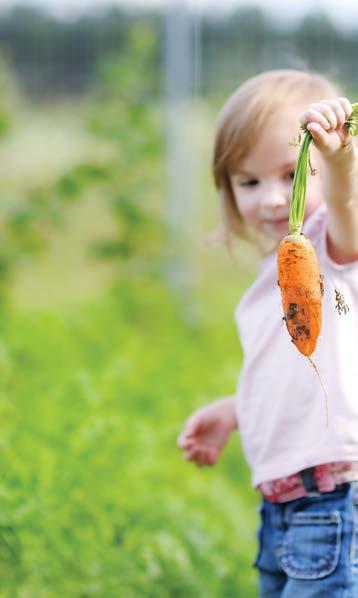
Tree support and leaning rows
Following the cyclone, many tree rows are on a lean but potentially recoverable. Experience suggests, now is the best time to straighten rows while the ground is still wet and soft. Once the ground hardens
it becomes almost
impossible.
In the short-term, growers have propped trees up as straight as possible with fencing battens. Refencing or additional fencing support can then come through later once the ground dries out.
Long-term challenges or limitations
Right throughout the management of this disaster, the Hawke’s Bay pipfruit industry has kept the long-term challenges and limitations front of mind.

Structural redevelopment
Many flood affected orchards have also experienced significant Infrastructural damage. Once growers have determined which blocks are salvageable and where replanting may be feasible, they can start to rebuild.
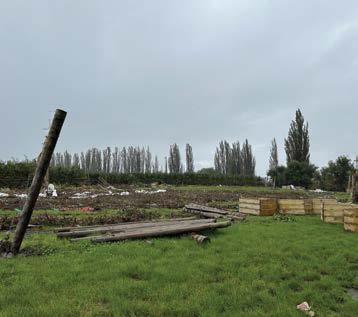
Nutrition and plant elicitors

With the stress the trees have been under, applying the required post-harvest nutrition and good plant stress elicitors will be useful. For nutrition and elicitor product options please talk to your consultant or spray rep.
Flooding modifies soil fertility and nutrient availability. Soil testing once blocks are cleaned up would be useful to inform an ongoing fertiliser programme.
It is important nutrient soil tests are taken after the clean-up has been completed and the grass sward has been resown. One thing’s for sure, we are in this for the long haul. We will rebuild and continue to grow the best quality apples in the world in our horticultural haven – the Hawke’s Bay.
Available at:
100% natural, BioGro certified


Supplies readily available source of calcium and sulphate sulphur to support soil health and plant growth.
For more information go to gypsum.co.nz
 Figure 5 infrastructures destroyed and landscapes changed
Figure 5 infrastructures destroyed and landscapes changed
It all starts with healthy soil.
The ORCHARDIST : APRIL 2023 57 TECHNICAL
A summer of floods and droughts, and very warm
Ben Noll and Gregor Macara : National Institute of Water and Atmospheric Research (NIWA)
Summer 2022–23 in Aotearoa
New Zealand was marked by striking contrasts across the two islands.
February 2023 will go into the record books as a month during which
Aotearoa New Zealand experienced one of its worst weather disasters in modern history, by way of an ex-tropical cyclone. Two ex-tropical cyclones, Hale and Gabrielle, impacted the North Island during the summer months. Hale resulted in considerable damage and Gabrielle caused widespread devastation, including unprecedented flooding, severe coastal erosion, and loss of life. A national state of emergency was declared, for only the third time in New Zealand’s history.
The North Island experienced exceptionally wet conditions across much of summer, with Auckland, Northland, Bay of Plenty, and Hawke’s
Bay all experiencing their wettest summers on record – marred by several bouts of extreme rainfall and devastating flooding, including an event where Auckland recorded over 280 percent of its normal January rainfall in under six hours.
In contrast, the South Island saw prolonged periods of hot, dry and sunny weather, leading to some areas experiencing meteorological drought, as measured by NIWA’s New Zealand Drought Index (NZDI).

Persistent La Niña – for the third year running – played a big part Cyclone Gabrielle occurred amidst a unique set of climate drivers –specifically, a La Niña ‘triple dip’ (third consecutive), which although its strength was waning, continued to have a meaningful influence on New Zealand’s weather patterns.
NIWA SEASONAL CLIMATE OUTLOOKS
Predictions of temperature, rainfall, soil moisture and river flows. niwa.co.nz/outlook

As is typical of La Niña summers, higher-than-normal air pressure was observed to the east and south of New Zealand, while lower-thannormal air pressure was recorded to the north and west. This resulted in more easterly and northeasterly winds than usual, drawing in warm and humid air from the tropics and sub-tropics.
Other climate drivers also contributed to warm temperatures
Adding to the warmth, humidity and moisture availability for passing lowpressure systems, was a protracted marine heatwave that peaked in January. The sea surface temperatures for February were the warmest on record in the west and east of the South Island, and second-warmest on record in the north of the South Island.
The Southern Annular Mode (SAM) was mostly positive throughout the summer, but dipped into negative in February when ex-tropical Cyclone Gabrielle arrived. A positive SAM during summer is usually associated with belts of high pressure near the South Island, which was indeed observed during summer 2022–23. Temperatures during the summer were generally above average, with some areas experiencing well above average temperatures. All three months were in the top ten warmest on record.
The nationwide average temperature for summer 2022–23 was 17.9°C, which was 1.1°C above the 1991–2020 summer average from NIWA’s seven station temperature series, which begins in 1909.
SUMMER 2022 | 2023 32 LOCATIONS HAD A RECORD OR NEARRECORD WET SUMMER 58 The ORCHARDIST : APRIL 2023
Looking ahead to autumn
New Zealand is expected to experience a transition from La Niña to El Niño Southern Oscillation (ENSO)-neutral conditions during March, resulting in more variable air flow, temperature and rainfall patterns during autumn.


Low pressure is expected to occur more frequently over the Tasman Sea and the South Island, leading to spells of westerly winds –a distinct change from summer. These westerly winds, while not dominant, will bring some more typical cold fronts.
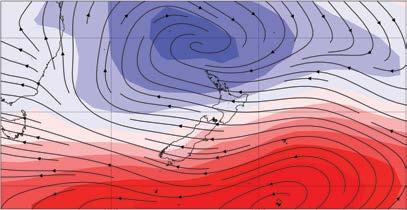
Rainfall is equally likely to be near normal or above normal in the east of the North Island, and most likely to be near normal in all other regions. In the North Island, this represents a drier signal compared to previous outlooks.
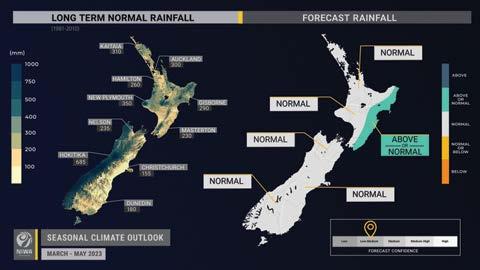
Low pressure systems to the western side of both islands are expected to produce rainfall that will gradually ease long-term rainfall deficits in the west and south of the South Island. However, the remnant effect of La Niña could still produce some sub-tropical and/or tropical lowpressure systems, occasionally increasing the risk for heavy rain in the North Island.
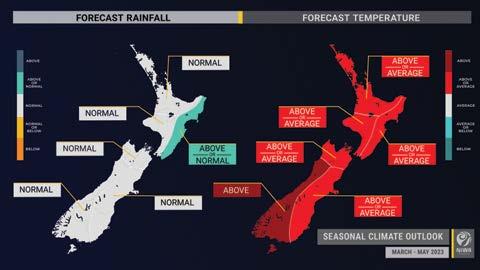
Seasonal temperatures are most likely to be above average in the west of the South Island and about equally likely to be near average or above average in all other regions. Cold spells will become more common as autumn progresses, and this transition will be accompanied by an increasing risk of frosts.
NIWA’s scientists are monitoring the chances for a transition to El Niño conditions during winter. El Niño tends to be associated with drier conditions in the North Island and eastern South Island during winter. The likelihood of a transition to El Niño will be updated each month in NIWA’s seasonal outlooks available on the NIWA website.

Article sponsored by
Mean Sea Level Pressure (hPa) & Air Flow Anomalies 1 Dec 2022 – 28 Feb 2023 30°S 40°S 50°S 160°E 180°E 160°W The ORCHARDIST : APRIL 2023 59
Mean sea level pressure (MSLP) and air flow anomalies during summer 2022–23. Blue colours indicate lower than normal MSLP and red colours indicate higher than normal MSLP
The new John Deere 5ML is coming
The new John Deere 5ML Series of cab tractors, designed to meet the unique needs of producers of high-value crops, is one step closer to landing in local paddocks.
Last month, leading John Deere dealers from Australia and New Zealand had the opportunity to experience the new equipment in the field during a training session in California’s Central Valley, one of the United States’ largest agriculture growing regions.
John Deere’s Australia and New Zealand Precision Ag Manager, Benji Blevin, said the dealers were excited to offer horticulture customers a tractor with a filtered cab and the latest precision ag technology, specifically designed to fit between tight orchard rows.
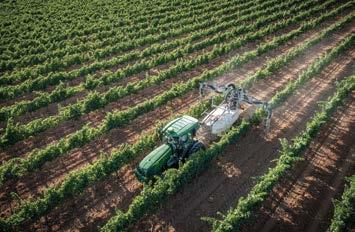
“Seeing the new 5ML in action in the US only heightened our excitement to bring the tractor to New Zealand to respond directly to the needs of growers looking for a lowprofile cab, more power, and industry-leading integrated precision ag technologies, typically only available on machines in broadacre production systems,” said Mr Blevin. Mr Blevin said a key point of anticipation was the Category IV Filtration System Kit, which if installed, provides additional cabin filtration and pressurisation, preventing external chemical and particulate hazards from reaching the operator and eliminating the need for personal protective wear.
“We had the opportunity to sit in the tractor, and many were surprised by just how spacious and comfortable the cab was given it has been designed for those narrow rows,” he said.
“The new inclusion of the cab and optional filtration system is a major step change in improving the health, safety and comfort of operators across New Zealand horticulture production enterprises.”
John Deere’s commitment to permanent crop producers was also on display in the US, with the Smart-Apply® Intelligent Spray Control SystemTM spraying technology demonstrated alongside the 5ML. The system is an addon kit for tow-behind air-blast sprayers which can reduce the potential for chemical drift and decreases the amount of product applied by adjusting spray volume based on canopy density using LiDAR and technology.
“Most sprayers today apply a blanket spray, even between trees. Smart-Apply adjusts spray volume based on tree canopy density and shuts off completely between trees,

providing an enormous chemical saving for producers,” Mr Blevin said.
In addition to Smart-Apply, the 5ML will bring a suite of technology to orchard and vineyard operations, making industry-leading precision farming capabilities available to growers to improve efficiency and production.
“JDLinkTM is available to track machine data remotely, allowing customers with fleets of tractors to manage equipment location, monitor machine health and productivity, and give their team the information and direction they need to finish jobs accurately and on time,” he said.
“The range is also Greenstar/ISOBUS ready for ratecontrolled implements, to help more accurately apply liquid and dry products, and documenting those applications for record-keeping and analysis.
“AutoTracTM basic also comes as an option, offering hands free guidance at a lower cost than ever from John Deere, giving customers the ability to eliminate implement overlap and optimise machine efficiency when completing jobs such as spraying, planting, and mowing.”
The 5ML and 5ML Narrow are available to order now. Customers can contact their local John Deere dealer for more information or to arrange a demonstration.
About Deere & Company:
Deere & Company is a global leader in the delivery of agricultural, golf & turf, construction, and forestry equipment. We help our customers push the boundaries of what’s possible in ways that are more productive and sustainable to help life leap forward. Our technology-enabled products including the John Deere Autonomous 8R Tractor and See & Spray™ are just two of the ways we help meet the world’s increasing need for food, shelter, and infrastructure. Deere & Company also provides financial services through John Deere Financial. For more information, visit John Deere at its worldwide website at JohnDeere.com or in Australia at JohnDeere.com.au.
60 The ORCHARDIST : APRIL 2023 WHAT’S NEW
John Deere will transform its offering to the horticulture industry with the new 5ML series of cab tractors
3
Send us your nominations for the 202 Horticulture Industry Awards

HortNZ is calling for nominations for its 2023 Awards to be presented at the Horticulture Conference Gala Dinner.

HortNZ will present up to one award in each of the following categories each year.
BLEDISLOE CUP
Awarded for an outstanding and meritorious contribution to the New Zealand horticulture industry.
PRESIDENT’S TROPHY
To celebrate and develop inspiring leadership within the horticulture industry.
INDUSTRY SERVICE AWARD
To recognise people with long and dedicated service in a supplier or service role (not a grower) that have worked beyond the call of duty for the betterment of the horticulture industry.
ENVIRONMENTAL AWARD
To recognise a person, or organisation, that has developed and implemented a sustainable environmental project, with identifiable benefits.
HORTNZ LIFE MEMBER
To recognise growers with long and dedicated service as office holders of H ortNZ and/or an affiliated Product Group or affiliated Grower Association.
Full criteria for the above awards are available on the Horticulture New Zealand website or can be requested from the Board Secretary.
Who can make nominations?
• Any grower member of HortNZ, an affiliated Product Group or an affiliated Grower Association can make nominations.
How do I nominate someone?
•Complete a nomination form. These are available on our website www.hortnz.co.nz or can be requested from the HortNZ Board Secretary via email admin@hortnz.co.nz or by phone 0508 467 869
When will the awards be presented?
•At the 2023 Horticulture Conference Gala Dinner on Wednesday 2 August 2023 at Te Pae Christchurch Convention Centre
When do nominations close?
•Nominations must be sent to the HortNZ Board Secretary, via email admin@hortnz.co.nz or PO Box 10232, Wellington 6140 and must be received by 5.00pm on Tuesday, 6 June 2023.
Send
us your nominations now!
THE TAILOR-MADE ORCHARD AND VINEYARD SPECIALIST
Introducing the exciting new 5ML Series. Because your needs as a grower are unique, we’ve built a tractor to match. Master tight rows with supreme ease thanks to its narrow axle. Remove discomfort from long days in the driver’s seat with its ergonomically designed cab. Take advantage of its premium features purpose built into a size suited to your operations. Continue to grow your efficiency and production with a suite of advanced precision ag technology, including JD Link, to help you better track and manage fleet performance.
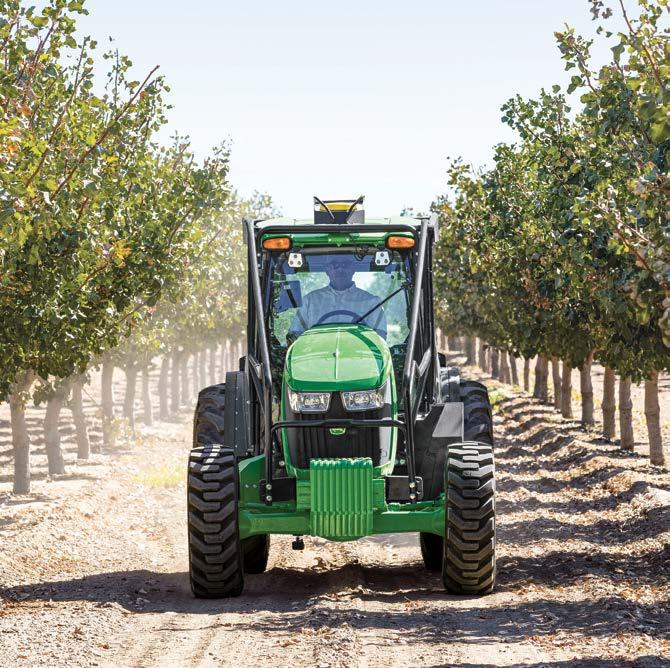
Talk to your local dealer today to find out more.

Deere.com.au/specialtytractors










 Kia kaha.
The first HortNZ board: back row (L to R): Debbie Hewitt, Peter Scott, Ru Collin, Peter Silcock (chief executive), Tony Ivicevich, David Eder, (seated) Brian Gargiulo, Andrew Fenton (president) and John Allen
Kia kaha.
The first HortNZ board: back row (L to R): Debbie Hewitt, Peter Scott, Ru Collin, Peter Silcock (chief executive), Tony Ivicevich, David Eder, (seated) Brian Gargiulo, Andrew Fenton (president) and John Allen

 Michelle Sands : HortNZ strategy and policy manager
Michelle Sands : HortNZ strategy and policy manager



 Greengage
Greengage

























 Jo and Brent’s home on wheels for more than a decade
Lucy and Kevin are in the packhouse this year
Jo and Brent’s home on wheels for more than a decade
Lucy and Kevin are in the packhouse this year



























 Elaine Fisher
Elaine Fisher

 Dr Alistair Scarfe, co-founder and chief technology officer of Robotics Plus
Dr Alistair Scarfe, co-founder and chief technology officer of Robotics Plus
























 Brittany is one of a cohort of young people working in
Brittany is one of a cohort of young people working in































 Figure 3 Flood affected fruit
Figure 3 Flood affected fruit















